#cambridge fellows mystery series
Text
My media this week (6-12 Nov 2022)

📚 STUFF I READ 📚
😍👂The Monsters We Defy (Leslye Penelope, author; Shayna Small, narrator) - book blurb: "A woman able to communicate with spirits must assemble a ragtag crew to pull off a daring heist to save her community in this timely and dazzling historical fantasy that weaves together African American folk magic, history, and romance." and let me tell you how much I LOVED this. Love a heist. Love a SUPERNATURAL heist. Love a prickly female protagonist. Just a really fun, satisfying story!
😊The Case of the Undiscovered Corpse (An Alasdair and Toby and Cambridge Fellows Mystery #1) (Charlie Cochrane) - the 'mystery' solution is nonsensical & convoluted but that's not really the point, it's just the macguffin so two sets of amateur sleuths can team up and since I love all the characters I ain't mad about it. What I love most is seeing J&O as elder statesmen, still living their HEA after 50 years.
🥰Stop @’ing Me (It’s Giving me Anxiety) (isthatbloodonhisshirt (wasterella)) - really fun SMAU with music star Stiles and music YTer Derek. Really good characterizations, fun banter, Pringles discourse, absolutely zero realism about how their respective industries function, as the fanfic gods intend. Plus there's lots of great mocked up SM images and original songs BUT what I truly love most is that this author did an entirely duplicate version of the fic WITHOUT images for accessiblity. Fantastic.
💖💖 +88K of shorter fic so shout out to these I really loved 💖💖
I love you with my fingers on your sleeping hand (spectreink91) - The Witcher: Geraskier, 7K - reread - good modern 2nd chance romance AU with horse breeder Geralt and pop singer Jaskier
📺 STUFF I WATCHED 📺
Ghosts - s2, e6-7
Doctor Who - s13, e7-8
Abbott Elementary - s2, e1-7
Living Single - s1, e5-6
M*A*S*H - s1, e17
Weird: The Al Yankovic Story - which was as delightfully & surrealistically nonsensical as one could hope
🎧 PODCASTS 🎧
Strong Songs - Pink Floyd: The Dark Side of the Moon
Vibe Check - The House Is Burning
The Atlas Obscura Podcast - Laguna Del Diamante
Switched on Pop - The Sound of Sapphism
The Atlas Obscura Podcast - The Wren’s Nest
Still Processing - Summer Renaissance
Twenty Thousand Hertz+ - Found in Translation
Richmond Til We Die: A Ted Lasso Podcastz - Ted Lasso S2E10: Funerals Are So Weird
99% Invisible #514 - Train Set: Track Two
Ologies with Alie Ward - Discard Anthropology (GARBAGE) with Robin Nagle
One Year Plus - 1942: The Info Wars of World War II
The Atlas Obscura Podcast - Moving Monuments with the Places Team
🎶 MUSIC 🎶
Lena Hall's Obsessions
Doctor Who Series 13 - Flux (Original Television Soundtrack)
'60s Folk Rock
Essential New Wave
Buena Vista Social Club
An Evening With Silk Sonic [Silk Sonic]
Presenting Blue Öyster Cult
Electronic Film Scores
Songs From Animated Movies
"Weird Al" Yankovic
Classical Focus
#sunday reading recap#bookgeekgrrl's reading habits#bookgeekgrrl's soundtracks#cambridge fellows mystery series#fanfic ftw#doctor who#vibe check podcast#20k hz podcast#the atlas obscura podcast#strong songs podcast#99% invisible podcast#richmond til we die podcast#switched on pop podcast#one year podcast#still processing podcast#ologies podcast#lena hall#buena vista social club#silk sonic#blue öyster cult#'weird al' yankovic
3 notes
·
View notes
Text
Review: The Case of The Undiscovered Corpse (Cambridge Fellows/Alasdair and Toby Mystery ) by Charlie Cochrane
Review: The Case of The Undiscovered Corpse (Cambridge Fellows/Alasdair and Toby Mystery ) by Charlie Cochrane
Rating: 4.5🌈
It’s wonderful to return to those fabulous Cambridge Dons Orlando Coppersmith and Jonty Stewart, now in their 70’s, still living happily together in Hyacinth Cottage, and teaching at their beloved St. Brides College.
It’s 1952 when a movie producer with an idea for a potentially new film script featuring comes calling for the pair in Cambridge. The script would feature a real life…

View On WordPress
#newbookreleases#A MelanieM Review#author Charlie Cochrane#combined series#established couples crossover#LGBTGIA historical mystery#M/M Romance Mystery#Review: The Case of The Undiscovered Corpse (Cambridge Fellows/Alasdair and Toby Mystery ) by Charlie Cochrane#Scattered Thoughts Highly Recommended
0 notes
Text
Emily Wilde's Map of the Otherlands release!
When mysterious faeries from other realms appear at her university, curmudgeonly professor Emily Wilde must uncover their secrets before it’s too late in this heartwarming, enchanting second installment of the Emily Wilde series.
Emily Wilde is a genius scholar of faerie folklore—she just wrote the world’s first comprehensive of encylopaedia of faeries. She’s learned many of the secrets of the Hidden Folk on her adventures . . . and also from her fellow scholar and former rival, Wendell Bambleby.
Because Bambleby is more than infuriatingly charming. He’s an exiled faerie king on the run from his murderous mother, and in search of a door back to his realm. So despite Emily’s feelings for Bambleby, she’s not ready to accept his proposal of marriage. Loving one of the Fair Folk comes with secrets and danger.
And she also has a new project to focus a map of the realms of faerie. While she is preparing her research, Bambleby lands her in trouble yet again, when assassins sent by Bambleby’s mother invade Cambridge. Now Bambleby and Emily are on another adventure, this time to the picturesque Austrian Alps, where Emily believes they may find the door to Bambley’s realm, and the key to freeing him from his family’s dark plans.
But with new relationships for the prickly Emily to navigate and dangerous Folk lurking in every forest and hollow, Emily must unravel the mysterious workings of faerie doors, and of her own heart.
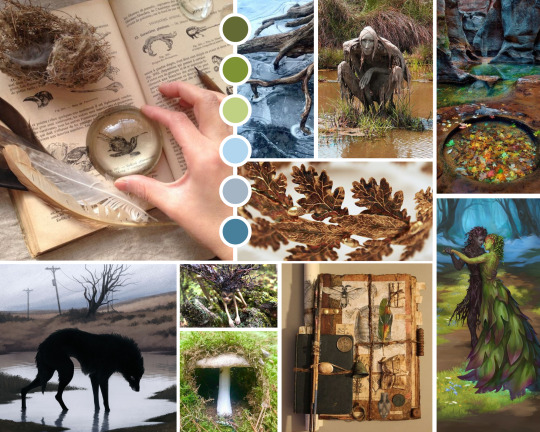
Bookshop.org
Barnes & Noble
Emily and Bambleby are at it again! This time they have some new characters to accompany them, including their skeptical boss and Emily's eager niece. This book definitely has different vibes compared to Encyclopaedia, but there's still lots of weird faerie shenanigans and Emily being Emily.
I liked getting to see different kinds of faeries and their tricks in this one, and the Alpine fae are wildly different, but also scarily similar, to the frozen fae of Hrafnsvik. I also liked getting to see more of the Otherlands themselves. I think there's going to be a book 3, so I'm looking forward to seeing what Emily, Bambleby, and co. get up to in that one!
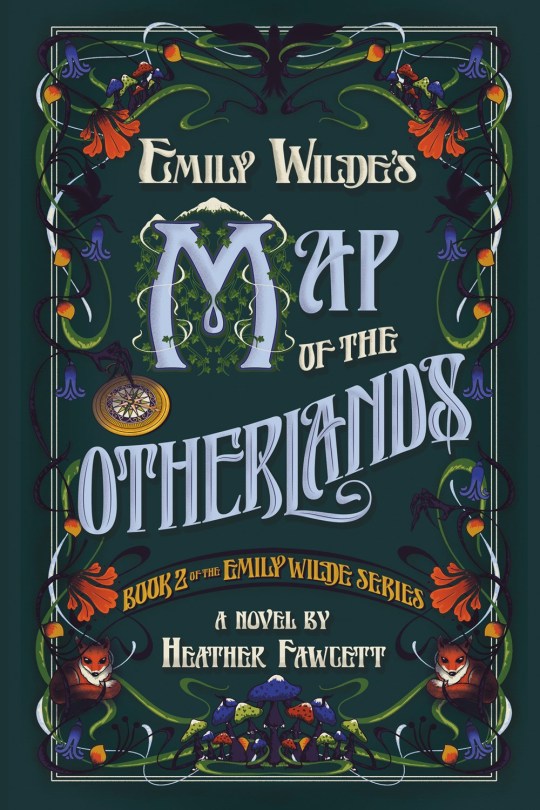
If you're new to Emily Wilde's world, you can find my review for Emily Wilde's Encyclopaedia of Faeries here! For current fans of Emily, my full review of Map of the Otherlands can be found here!
#book#books#fantasy#book recommendations#bookstagram#booklr#bookblr#bookaholic#bookish#emily wilde’s encyclopaedia of faeries#emily wilde's map of the otherlands#heather fawcett#fantasy books#epistolary narrative#faeries#advanced readers copy#book release#book birthday#netgalley#netgalley reads
8 notes
·
View notes
Text
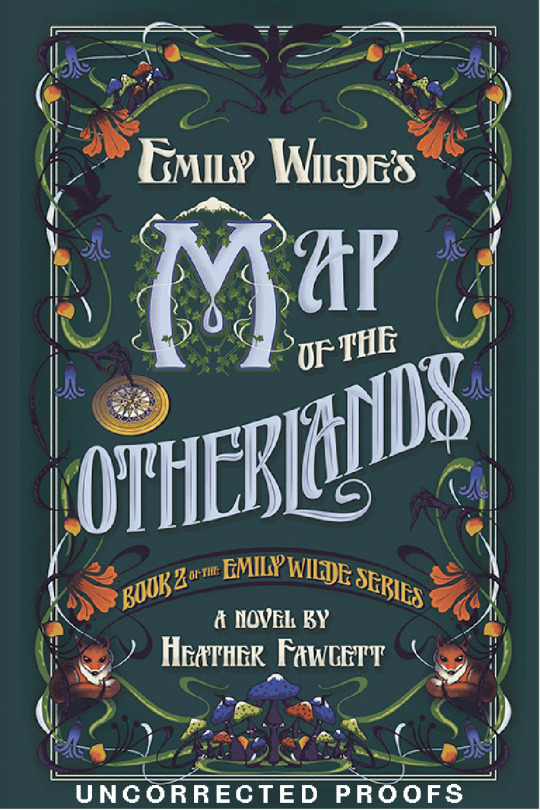
Rating: 5/5
Book Blurb: When mysterious faeries from other realms appear at her university, curmudgeonly professor Emily Wilde must uncover their secrets before it’s too late, in this heartwarming, enchanting second installment of the Emily Wilde series.
Emily Wilde is a genius scholar of faerie folklore who just wrote the world’s first comprehensive encyclopaedia of faeries. She’s learned many of the secrets of the Hidden Ones on her adventures . . . and also from her fellow scholar and former rival Wendell Bambleby.
Because Bambleby is more than infuriatingly charming. He’s an exiled faerie king on the run from his murderous mother and in search of a door back to his realm. And despite Emily’s feelings for Bambleby, she’s not ready to accept his proposal of marriage: Loving one of the Fair Folk comes with secrets and dangers.
She also has a new project to focus on: a map of the realms of faerie. While she is preparing her research, Bambleby lands her in trouble yet again, when assassins sent by his mother invade Cambridge. Now Bambleby and Emily are on another adventure, this time to the picturesque Austrian Alps, where Emily believes they may find the door to Bambleby’s realm and the key to freeing him from his family’s dark plans.
But with new relationships for the prickly Emily to navigate and dangerous Folk lurking in every forest and hollow, Emily must unravel the mysterious workings of faerie doors and of her own heart.
Book Two of the Emily Wilde Series
Review:
Emily Wilde and Wendell (with Shadow) are all back for another adventure filled with fae adventure, new friends, and romance! After the previous adventure, Emily now has tenure and has published her encyclopedia of faeries, she has also not given Wendell an answer to his proposal because becoming the queen of a fae kingdom is not something Emily is sure she is ready for. She is however, ready to help Wendell find the nexus door to his kingdom... the only problem? His Stepmother (and current ruler of his kingdom) has sent assassins after them and she knows about Emily. Emily's search for Wendell's door as well as her new project, mapping the realm of the faerie is definitely going to keep her occupied. Along for the way is her niece, Ariadne who is her new assistant, and an opposing academic, Rose, a grumpy older man who wants to come along with Emily despite his strong dislike of faeries. Emily, Wendell, Ariadne, Rose, and Shadow (of course) are now going to the Austrian Alps to find Wendell's door... but can they evade all the dark forces Wendell's stepmother is sending after them and will Emily finally give Wendell an answer? This one is a FANTASTIC sequel to the first book, in fact I love it even more. I adore Wendell and Emily's relationship so much. The romance definitely ramped up in this one and the fun adventure in this story was so enjoyable. Emily is hilarious and I love how brave and strong she is. She's an academic and not afraid to get after what she wants. You get to see her grow more in this one and open herself up to more people, particularly her niece and even getting a rival academic to become her friend. We get some familiar faces and cameos from the first book too. The story is such a fantastic cozy fantasy romance, and it's got me smiling and giggling while reading it. I adore this series so much and can't wait to see what Emily and Wendell get up to next!
*SPOILER:
Wendell's stepmother poisons him and he's pretty out of it most of the book however Emily does find the door and visit's Wendell's kingdom and poisons his stepmother. She gets his cat, Orga, and takes her back as she is the only way to cure Wendell ( who was poisoned and Orga killed the poison that was seeping into his skin). Emily does say yes to Wendell's proposal. At the end of the book they lose access to the door and Wendell still needs to reclaim his throne. Emily ends the book getting ready to publish her mapbook. She does make friends with Rose and Poe (our fav little bread baking faerie appears again).
*Thanks Netgalley and Random House Publishing Group - Ballantine, Del Rey for sending me an arc in exchange for an honest review*
4 notes
·
View notes
Text
Embers - Male dragon shifter x reader, Chapter Twelve (v.light nsfw)
Can you believe that this story is nearing 20k words now in total? It's going to start winding up soon, with only two chapters left. Thank you for the support you’ve shown me for this long-running series - I hope you enjoy what remains of their story.
(Old Trollbridge is based on Cambridge, UK. Also, in the UK, the ‘first floor’ is what Americans call the second floor; I only remembered this difference after my trip to Boston last year, so I thought I’d mention it, haha…)
No warnings, mostly sfw with a bit of very light kissing, and about 1700 or so words.
One, Two, Three, Four, Five, Six, Seven, Eight, Nine, Ten, Eleven
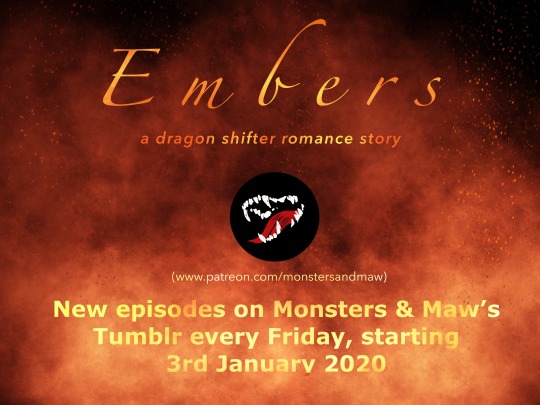
The night of the fundraiser rolled around eventually and you decided that since Mikaeïl would be helping to set things up beforehand, you would simply meet him there. Old Trollbridge was an ancient city, its history stretching back nearly a thousand years, and the university structure was unlike almost anywhere else, except for perhaps Oxenford or Dunholme, with almost thirty individual colleges where students were based and where some of the learning was based, while the majority of their lectures took place in the larger department and faculty buildings. Mikaeïl’s college - where the dinner was being hosted - sat on the old, sluggish, shallow river which coiled lazily through the buildings of the city which had grown up around it over the centuries.
More than a little outmoded in many ways, and highly intimidating to the uninitiated, the college which had been chosen for the evening was one of the oldest in the university. It was here, in the fellows’ dining room, rather than the communal hall, that the dinner was being hosted in order to raise funds for two charities supported by the Law Faculty, and more specifically, the criminology department.
Despite having worked in Old Trollbridge for the past five years, both as a free-lancer and part-time for the graphic design company, you had never set foot inside one of the colleges. It felt like sacred ground somehow; inaccessible to your profane feet. This one was built of a mix of warm sandstone and weathered brick and flint, and as you stepped into the archway that housed the Porters’ Lodge, a large minotaur wearing a dark green waistcoat with the college insignia exited the office and smiled out you. “Here for the dinner?” he asked, glancing at your smart outfit.
“What gave it away, the nerves or the clothes?”
“Both?” he laughed and raised his hand, pointing at an archway across the grassed court from the lodge. “Head over there. Follow the signs, and you can’t go wrong.”
“Thanks,” you said, swallowing the huge lump in your throat. Your heart raced. This was not your usual environment. At all.
It was Mikaeïl's, however, and somehow it didn’t seem so intimidating then. He made his home within these walls, and had done for over a century apparently. He even had a set of rooms in college, but he rarely used them. You began to look around you more closely then, at the mullioned windows and the Virginia creeper climbing up the drainpipes in the corners of the courtyard, and at the faces of the one or two students who passed you by as you made your way around the paved courtyard.
A gnoll with a chunk missing from one ear gave you a wide, toothy grin and a friendly wag of her tail, and a moment later a naga slithered out from a doorway, looking a little unsteady, with a dryad at his side, laughing loudly. The pair were more than two sheets to the wind, but it was a Friday night and you supposed that they worked hard here; they deserved a night off like everyone else.
A moment later, however, and you were walking through the doorway into the part of the college usually reserved for fellows and lecturers only, and a rather nervous looking young human, again wearing the college colours, stepped forwards to take your ticket from your hands. “It’s on the first floor,” she said, indicating the lift and the staircase which sat side by side. “Can I take your coat?”
“Uh, thanks,” you croaked, shrugging out of it. “Is everyone else here already?”
She shook her head. “A couple more to go,” she smiled, taking your jacket and hanging it on a rack to one side.
Nodding, you headed upstairs.
Pausing in the doorway to the panelled dining room, which was immediately opposite the lift, your breath caught in your throat. Mikaeïl was standing the far side of the room, talking to a handsome, young-looking orc in a manual wheelchair, and both had exquisitely beautiful champagne flutes in their hands. While he looked like a classical statue come to life, Mikaeïl had been right when he’d warned you that he would be almost a different person when you saw him in this context.
His back was ramrod straight, his mouth was set in a hard line, and he looked like he was about to breathe fire all over the poor orc. You recognised the signs now as intense social discomfort, and your heart went out to him. Bless him, for all his two hundred years, socialising had never become something he had learned to enjoy. Perhaps it was because his kind had been hunted almost to extinction by orcs and humans about five hundred years earlier, and shifters like him had learned to keep to themselves.
The moment you entered the room, however, he shot you a quick sidelong glance, reptilian eyes drawn to the movement, and then did a very unsubtle and obvious double-take. His shoulders dropped an inch, and his breath caught in his chest. Well, that was an ego boost for you for sure. Smiling, you made your way around the beautifully laid table and stood shyly beside him.
“Hi,” you murmured, glancing nervously between him and the orc.
“You look incredible,” he murmured, leaning close and kissing your cheek before introducing you as his partner to the orc. “This is Gharak. He’s halfway through a PhD in geophysics.”
“Wow. Nice to meet you,” you blurted, shaking the orc’s enormous hand before sliding your own around Mikaeïl’s waist. He tensed beneath your touch, but then laughed softly.
“I think we’ll be starting soon. Almost everyone is here…”
The murder mystery dinner wasn’t quite what you’d expected, but it was mostly pretty fun. The people who had bought tickets were… astonishingly wealthy. Like… you’d thought that Mikaeïl with his inherited wealth was well off, but most of these people were in a different league. The food was sublime, unlike anything you’d ever tasted even at Kiriavin’s cellar restaurant, and you found it an effort to wrench yourself from your meal to play along with the loose ‘script’ of the evening.
Mikaeïl was seated across from you, beside an older human woman who wouldn’t stop fawning all over him. If it hadn’t been your boyfriend, it might have been funny, but as it was, your heart went out to him. He’d whispered to you during the pre-dinner drinks that she was a major benefactor, not only to the department but to the university itself, and knowing this, you knew he couldn’t rebuff her attentions.
He did his best to weather it, but at one point he caught your eye and the look in his hard, golden gaze was so miserable that you found yourself instantly mouthing the words ‘I love you’ to him across the third course of the dinner.
At that, his cheeks flushed gently, and he mouthed back, ‘thank you’.
When it was finally over, and the mystery - such as it was - had been solved, you bid goodnight to Gharak, who had been sitting next to you and who had been an absolute blast, and crossed to Mikaeïl. He was standing with one hand gripping the back of his chair so hard you could hear it splintering beneath his fingers, and as you placed your own hand over the top of his, the tension washed out of him.
“You alright?” you asked. “I think that went pretty well?”
He nodded. His hair was tied back in a severe bun, with what looked like a solid gold hair pin topped with a dragon holding it in place, and his dinner jacket fitted him to perfection. He looked like the subject of an oil painting, and just as uncomfortable still.
“Mikaeïl?”
He inhaled, his nostrils going wide. And then his hands were on your jaw and he kissed you so hard you saw stars. The room was empty now, and as the two of you kissed, he growled softly in that low-frequency rumble that you could feel in your ribcage. It filled the room and made the glasses rattle and ring on the table. His hands began to shift again, copper claws growing as colour rippled up his forearms beneath the crisp white shirt, talons pricking into the fabric of your own clothes before he could stop himself.
“Mikaeïl?” you murmured again. “Let’s go?”
He nodded.
“You want to come back to mine or…?”
“I don’t care,” he said. “I just want you. I can’t believe how amazing you were tonight.”
“Me?” you asked. “I barely did anything… I just played my role of poor starving artist - hardly imaginative, I might add -” you said with a playful glint in your eye, “And the others solved the mystery themselves…”
“Not that,” he snarled dismissively, his lips rising on one side to show his elongated canines. “You knew…”
“Knew what?” you chuckled affectionately, bringing your fingertips to his slightly pointed ears and tucking a wayward strand of his fiery hair behind it, gently enough to make him shiver visibly.
He swallowed and kissed you again in answer. When he was done, he pulled back and said, “You knew when I got overwhelmed. How?”
You had to laugh at that. “Your body got all tense - well, even more tense than usual - and you looked like you were considering incinerating her where she sat…”
“I wouldn’t want to destroy a Chippendale,” he said flatly and you burst out laughing, tipping your head back. A second later, he raked the very tip of his clawed thumb down your throat and your laugh changed to a groan.
“Let’s get out of here,” you said, and he nodded.
“Your place is nearer…” he added, nipping your thrumming pulse with his teeth as he kissed your neck.
You didn’t argue.
“By the way,” he added as you took his hand and left the college behind you.
Glancing up at him, you smiled. “Mmm?”
“Are you free next weekend? I have a surprise for you…”
Your eyebrows sailed high. “What kind of surprise… You know I’m not wild about surprises…”
“Bring something warm to wear,” he said. “That’s all I’ll say for now.”
Part Thirteen
—
I really hope you folks enjoyed this one! Don’t forget to let me know if you did enjoy it by leaving a like and/or reblogging it!
For all early releases, character art and bios, upcoming story info, and much, much more, join me over on Patreon! (no new content planned in March (and no charge to existing patrons) but access to everything else is available)
You’ll have access to stories before anyone else, and you’ll get instant access Patreon-only content as well, including polls and an exclusive monthly story for those on the Pixies and Goblins tier or higher!
__
| Masterlist | Patreon | Ko-fi | Writing Commissions |
#exophilia#dragon shifter#dragon x reader#male dragon x reader#male dragon shifter x reader#gender neutral reader#male dragon#embers
224 notes
·
View notes
Photo
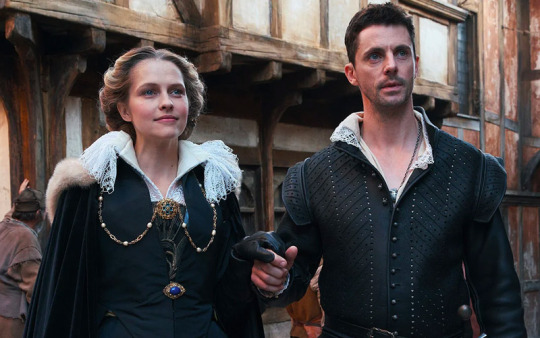
https://www.fanbolt.com/113000/a-discovery-of-witches-season-2-review-upholding-shadow-of-the-nights-spirit/
‘A DISCOVERY OF WITCHES’ SEASON 2 REVIEW: UPHOLDING SHADOW OF THE NIGHT’S SPIRIT
Spoilers Below.
A Discovery of Witches Season Two, written by Kate Brooke, Tom Farrelly, Charles James, and Sarah Dollard, keeps the All Souls Trilogy second book’s spirit while creating something unique, leaving viewers desperate to see more.
Season 2 is directly based on Shadow of the Night by Deborah Harkness. British Vampire Matthew Clairmont and American witch Diana Bishop travel back to Elizabethan London to hide from the Congregation. Meanwhile, in the present, their families try to find a way to make sure the couple is safe. Matthew and Diana need to find the Book of Life to stop daemons, vampires, and witches from dying out.
Diana is a true feminist hero. Since her parents died, she has refused to embrace her witch nature. Instead, she dove into the world of history. She is a historian who studies alchemy and science. Even the little spells that Diana’s Aunts, Sarah Bishop and Emily Mather, taught her as a child were significant failures.
Last season, Diana discovered that her father, Stephen Proctor bound her powers to protect his daughter from the greedy witch Peter Knox. When she started to fall in love with Matthew, her abilities began to manifest. After fellow witch Satu accidentally broke the binding spell, Aunt Sarah and Aunt Emily still struggled to teach her spells.
In Season 2, Diana realizes she can’t learn spells because she is a “weaver.” Weavers are a subset of witches that can create their own spells, but they can’t do anything magical if the spell is created by somebody else. In Elizabethan England, weaver elder Goody Alsop teaches Diana the ten knots that allow her to develop spells and summon her familiar firedrake Corra. By fully embracing her witch nature, Diana takes back control of her life.
Last season, Diana needed protection because her powers only came out during dire situations. Now she refuses to let Matthew be her “protector.” The couple forms a true partnership.
When Diana and Matthew visit his father, the ancient vampire Phillipe de Clermont in Sept-Tours (France), the witch is tested multiple times. Phillipe brings the witch Monsieur Andre Champier to Diana while she is reading in his library. Champier is drawn to Sept-Tours because he can sense her great power. He tries to break into Diana’s head to steal all her memories. Diana’s mind flashes to images of her saving Matthew’s life and when she accidentally summoned witch wind at the Bodleian Library.
Champier realizes a vampire drank from her. She screams in pain when the male witch tries to remove her memories. Matthew hears her screams. He runs faster than light to Diana’s aid. When he enters the room, she summons one of his daggers. Diana stabs Champier in the heart, proving that she doesn’t need anybody’s protection. Phillipe now knows that the Clairmont family can trust his son’s great love with their secrets because Diana won’t let herself be compromised.
Matthew forgives himself and realizes that he is worthy of love. His vampire mother a.k.a. sire, Ysabeau de Clermont, is a blood rage carrier. This genetic disease causes loss of control and violent impulses triggered by strong negative emotions like rage. Over the centuries, Matthew has gained control of his blood rage. But when he is forced back to the Elizabethan court as Matthew Roydon, the vampire’s homicidal tendencies are re-awoken.
Roydon is a spy for the British royal court, cruel inquisitor, and Phillipe’s executioner. He kills the Scottish witch Thomas Caldwell to save him from further torture. Elizabeth II is afraid that Caldwell and all the other witches are no longer loyal to the British Crown. Matthew remains haunted by the fact that he mercifully killed his father Phillipe during World War Two. Nazi witches tortured Phillipe to the point of permeant physical and mental damage. Seeing his father again is painful for Matthew because he has never forgiven himself. Guilt brings the blood rage bubbling up to the surface when Phillipe tries to get Matthew to tell him his future. Matthew’s father won’t stop beating him with a sword until he becomes a raging animal. The son refuses to tell Phillipe anything.
Diana’s acceptance of everything Matthew is, including the blood rage, allows the two to mate and marry. Mating makes Matthew overly protective of Diana, but the two creatures create a true partnership.
Season 2 leaves viewers with a small mystery for the final installment of A Discovery of Witches. The show changes several details from the original text Shadow of the Night. One of the more minor changes is that Mary Sidney commissions two small portraitures of Matthew and Diana as gifts in the book. Matthew orders the portraitures for their adopted son Jack Blackfriars, a former street urchin in the television show. Before traveling to Sept-Tours, the couple leaves the paintings with Jack to comfort him. During modern times, Marcus Whitmore (Matthew’s vampire son) tries to buy the portraitures from an auction house, but they are stolen before he picks them up.
Meanwhile, treacherous vampire Domenico has been tracking a series of murders in Oxford, Cambridge. A vampire commits these murders in a blood rage. From the third book in the trilogy, The Book of Life, I know that Father Hubbard turns Jack into a vampire when he is a young man. In the present day, Hubbard’s sire Benjamin Fuchs tricks Jack into killing humans in a failed attempt to sire vampires and controls the young man by dangling Matthew in front of him. Jack’s extreme blood rage makes him easy to manipulate.
My theory is that Jack is the one who stole the portraitures since they technically belong to him. The young vampire would want to be closer to his “parents.” Like the third book, Jack murders humans in Oxford because he is under Benjamin’s control.
#a discovery of witches#book adaptation#tv show#british#diana bishop#Matthew Clairmont#witches#vampires#daemons#fanbolt#tv reviewer#reviewer#elizabeth i of england
7 notes
·
View notes
Photo
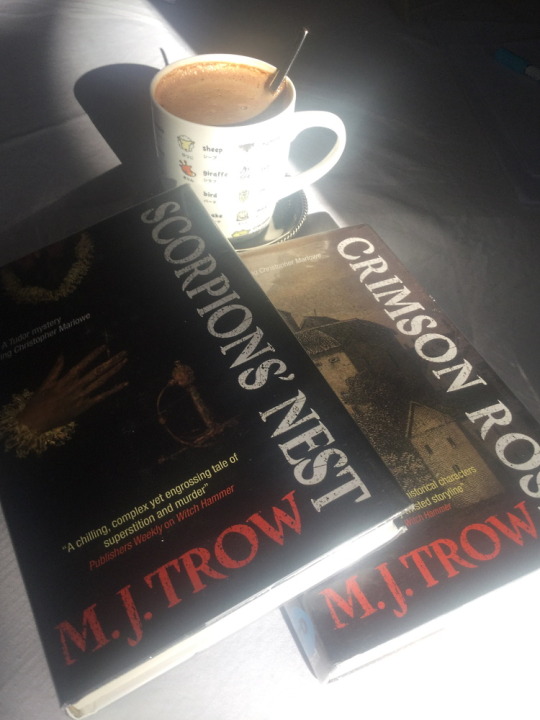
I’ve just finished reading the first 10 books from M. J. Trow’s Marlowe Mystery Series. The books vary in quality, but all up I’ve absolutely enjoyed it.
It’s historical fiction, set in Elizabethan England, and revolving around the playwright Christopher Marlowe solving mysteries, working as a spy, and writing the plays he’s known for today.
The language isn’t completely period-accurate, but I assume that’s to make it more readable for a modern audience to immerse themselves in. Still, it’s solidly entertaining, with a fair amount of humour. It’s well researched, although obviously with some forgivable creative licenses taken.
The series starts off with Christopher Marlowe at 18/19, a student at Corpus Christi, Cambridge University, which was at the time a direct path to a career in the church, except that Marlowe's dream is to become a playwright in London. A modern equivalent of that would be someone who studies law or politics, gets their Master's degree, and then decides to become famous with a death metal band instead.
Marlowe starts off as a young scholar who spends most of his time doing what he likes (rather than what his teachers want from him), including getting drunk, fighting, and sneaking in and out of his college after dark. His fellow students call him “Machiavel,” and he's set up as a clever, cheeky troublemaker with a temper and impulse control issues. Luckily, trouble is a place in which he thrills at being; it excites him, and he has full confidence in his own abilities to handle anything.
But he's not without a heart, as much as some people around him might think so. He's a loyal friend and protective of the innocent. He has a sense of justice, and is willing to kill to put things right.
Marlowe is an atheist during a time when England was forcibly Protestant, at a time when churches still ruled daily life. As a result, the books mostly steer away from anything overly religious or supernatural, sticking with Marlowe's cynical, secular view.
Marlowe's homosexuality is hinted at, but there's no love interest in the first 10 books anyway (I haven’t read the 11th). Whether that's believable to you or not, you'll have to judge for yourself. The books choose to focus on the mysteries that drive them, and on the world around Marlowe, rather than on any emotional inner life.
As the series goes on, you get to know Marlowe as someone who picks up skills like a sponge, who only needs to hear something, see something, or try something once in order to remember it. He’s not always a reliable narrator, but he’s always sympathetic. While his relationships with the women around him are lovely, full of respect and empathy, partly because there's no kind of attraction there, and party because he grew up with five sisters, just as independent-minded as him.
There are plenty of historical figures who show up throughout the series, including William Shakespeare before he becomes famous. If you know your history that adds some nice little bonuses to the books, but it’s not really necessary to know who these people are before reading the books.
The books:
Book 1: Dark Entry - Set just as Marlowe is finishing his Bachelor degree at Cambridge, with a murder mystery among the students and teachers there. The book ends with Sir Francis Walsingham recruiting Marlowe for Her Majesty's Secret Service, and thus begins his career as a spy.
Book 2: Silent Court - Kit's first mission: head towards the Netherlands to protect the King. He does this by joining a caravan troupe of travellers where he learns tricks and sleight-of-hand, things that will serve him well later in his career as a spy. Very little of the book takes place in the Netherlands, and the plot does a whole lot of meandering before you figure out where it's all leading, and with a disappointing ending it's my least favourite book of the series. However...
Book 3: Witch Hammer - Builds directly on the last book, with Marlowe needing to rebuild his confidence, so that makes book 2 retroactively better. Marlowe joins a travelling theatre troupe and immediately has his first play stolen. We meet a young Will Shakespeare in Warwickshire and prove that witches are not real, but evil hearts and minds certainly are.
Book 4: Scorpion's Nest - Marlowe is sent to Catholic France to track down a fugitive. It's the last book set in an academic setting, and it's full of wonderful characters, and Marlowe always needing to stay one step ahead of the suspicious college authorities. One of my favourites.
Book 5: Crimson Rose - Marlowe has finally graduated with his Master's degree and made it to London, where his play, Tamburlaine, is starting to gain attention. London is a riot of personalities, actors, familiar faces, crime, betrayal, breaking Shakespeare out of gaol, harbouring him as a fugitive, and Marlowe then having to clear his own name on top of it all. It's loud and entertaining, and my personal favourite of the series.
Book 6: Traitor's Storm - Marlowe is sent to the Isle of Wight to find out what happened to a fellow agent, and discovers a whole series of murders. The book involves the Spanish Armada, pirates, and again, a bunch of wonderful personalities.
Book 7: Secret World - We get a glimpse of Marlowe's family, before he is once again swept up in a murder investigation that has something to do with Francis Drake, the English privateer. As Marlowe does his own investigating he meets a Jewish jeweller, gets briefly arrested for murder and inspired to write The Jew of Malta. There are seeds of Marlowe's eventual downfall by introducing Robert Poley, and ending with Marlowe having murder on the brain, but he’s never anything other than sympathetic.
Book 8: Eleventh Hour - After the death of Sir Francis Walsingham, Marlowe sets out to prove it was murder. We meet the School of Night, a group of thinkers, occultists, and early scientists, and Marlowe begins work on his most spectacular play, Doctor Faustus. It's a more sombre book than the others in the series.
Book 9: Queen's Progress - Sent ahead of the queen to scout out locations, Marlowe discovers a series of violent attacks that are a little too conveniently arranged. Along the way, he's joined by friends old and new, which leads to Henslowe's crew staging their greatest production so far: placing Queen Elizabeth herself centre stage.
Book 10: Black Death - The plague rages through London, but it's not the only killer stalking the streets. Marlowe just can't let a mystery lie, even when he hates the victim. The book introduces Bedlam, and comes full circle by Marlowe returning to Cambridge. The difference between the man he was when he left from who he is now is stark.
Book 11: The Reckoning, came out in 2020, and I haven’t read it yet, but with a title like that you know it’s going to be the last of the series. I’m not planning to read it yet either, because I’m still enjoying labouring under the delusion that if I don’t read it, it won’t end as badly as history says it will. I’m only half joking.
It’s not the greatest series ever, but I have thoroughly enjoyed the series as a whole. I’ve loved spending time with the characters and seeing their stories unfold. I almost wish there were more books in the middle there, with more historical characters and more adventures. I’m going to miss following this version of Kit Marlowe on his adventures.
Are the books meaningful or profound? Not really.
Are they historically accurate? Sometimes.
Are they entertaining? Oh, so much!
6 notes
·
View notes
Text

Well, even though quarantine and lockdown may slowly open up for many of us, it’s not over yet, and besides one can never have enough means to escape reality, so here are a few book reccomendations.
All books on this list are LGBTQ or at least have (important) characters who are.
The “Classics”:
Wraeththu - Storm Constantine (how is it no-one’s talking about this anymore? Please do take into account that those books were written in the early 1990s, they were way ahead of their times, and yet there may be some offensive things - it’s been a while that I’ve read them so I can’t come up with any example, but should you find them somewhat un-feminist, wait until the end xD)
The Left Hand of Darkness - Ursula K. Le Guin (a true classic)
The Last Herald Mage series - Mercedes Lackey (gee yes Vanyel can be a real brat - not quite without reason though, but you’ll come to love him xD And yes we all just pretend that scene in book 3 never happened -_-) (also: influenced the Nightrunner series)
The World of Riverside series - Ellen Kushner (another influence on the Nightrunner series)
The Doctrine of Labyrinths quartet - Sarah Monette (beware, those books are not for everyone, trigger warnings are in order: rape, violence, mental issues, abuse / none of this is ever glorified or belittled, but it’s there, and it is so much a part of the characters’ lifes that it might occasionally seem like it’s not appropriately treated. Speaking of characters: very complex, intriguing characters with very dark sides, but you gotta love ‘em; intricate, complex world building / Nowadays Sarah Monette writes under the pseudonym Katherine Addison) (as far as I know they are unfortunately out of print so you’d have to check second hand book stores)
Historical fiction (with or without the paranormal)
Whyborne and Griffin series - Jordan L. Hawk (lots of paranormal stuff, magic, Lovecraftian creatures, awesome ladies, and so much more - and you will love those boys so much xD)
Magic in Manhattan - Allie Therin (the Roaring 20s, magic, prohibition)
The Collin Pendragon Mysteries - Gregory Harris (imagine Sherlock Holmes and Watson were canon; whodunnit, Victorian England)
Restless Spirits - Jordan L. Hawk (let’s go ghost hunting: science vs. medium)
A Charm of Magpies - K.J. Charles (magpies - lots of them xP, magic, curses, intrigue, late Victorian England)
At Swim, Two Boys - Jamie O’Neill (set in Dublin around the Easter Uprising 1916; coming-of-age, tragic love story - don’t forget the tissues)
Cambridge Fellows Mysteries - Charlie Cochrane (Edwardian England, mystery, romance; amateur sleuths, found family)
SFF
The Priory of the Orange Tree - Samantha Shannon (epic fantasy, intricate world building, clash of religions, dragons, strong female leads)
The Affair of the Mysterious Letter - Alexis Hall (fantasy / mystery; Lovecraftian vibes, bizarre and witty retelling of Sherlock Holmes)
The Tarot Sequence - K.D. Edwards (alternative world, Atlantis, magic, god-like beings, found family; trigger warnings: mentions of rape, violence)
The Rifter series - Ginn Hale (fantasy, parallel world; god-like being, magic, religious strife, necromancy (in a way))
Iron Breakers trilogy - Zaya Feli (fantasy; intrigue, cultural differences, battles, fight for a kingdom, romance)
The Icefjord Saga - Zaya Feli (fantasy, Norse inspired world, magic, mythological creatures, battles, curses)
Tales from Verania - TJ Klune (fantasy, comedy, romance; hilariousness galore! - okay sometimes it’s a bit too much, but between all the jokes and sexual innuendoes, the story doesn’t suffer; basically everyone is gay, everyone tries to get into Sam’s trousers ^^;, did I mention the hornless gay unicorn that sweats glitter, and the sexually deviant dragon? xD)
Peter Darling - Austin Chant (fantasy, retelling; very interesting take on Peter Pan, takes place many years after the events in Peter Pan, focused on the relationship between Peter and Hook; the search for a place, for someone to accept you for who you really are)
YA and New Adult
Nevernight Chronicles - Jay Christoff (sometimes I’m amazed what’s YA nowadays; fantasy; anyway beware of all the blood)
Feverwake duology - Victoria Lee (see above; dystopia; Holy Baby Yoda but these two books are intense! triger warnings: abuse, drug use, violence, mentions of rape, deadly virus outbreak)
Only Mostly Devastated - Sophie Gonzales (contemporary; all the feels: it makes you laugh out loud, it makes you cry; Grease says hello, super sweet quick read)
Timekeeper trilogy - Tara Sim (steampunk - or should it be clockwork punk?; mythology, gods, concept of time, ghosts, cute boys, discourse on colonialism)
The Torch Keeper trilogy - Steven dos Santos (dystopia; betrayal, love between brothers, biological modifications, deadly deadly trials)
Proxy duology - Alex London (dystopia; the rift between rich and poor, unjust society, technology)
The Disasters - M.K. England (sci-fi; band of misfits to the rescue!; Breakfast Club in space - kind of xD)
Magnus Chase & the Gods of Asgard - Rick Riordan (fantasy, mythology; ahhh Uncle Rick - just got to love the man, seriously; Norse mythology, diverse cast, homelesness, found family, disablitiy) (I’m aware it’s officially labelled Middle Grade, but who cares. It is linked to the Percy Jackson series, but you don’t need to know it to read these books)
The TBR pile (meaning books I haven’t read myself yet, but they certainly are on my tbr list, so perhaps they will be on yours now, too):
The Locked Tomb series - Tamsyn Muir (fantasy)
The Bloodright trilogy - Emily Skrutskie (sci-fi, YA)
Wild Sky - Zaya Feli (fantasy)
The Extraordinaries - TJ Klune (romance, superpowers - or not..., YA)
Reverie - Ryan La Sala (fantasy)
Soulbound series - Hailey Turner (urban fantasy, romance)
Cemetery Boys - Aiden Thomas (fantasy, paranormal, romance, YA)
Micah Grey series - Laura Lam (fantasy)
Specials:
A Song for Ghosts - Manja Siber (historical, mid 19th century Dresden) - Don your fanciest dress and fetch the binocular, it’s opera time! Originally inspired by The Phantom of the Opera and Yuri on Ice - see if you can spot the hints xD (as a fellow Watcher, Manja kind of makes the list by default* xP Give it a try, you can find it via epubli or on amazon.de)
*No, this isn’t nepotism, I’m just trying to give the support I wish I had. So if you’re an author and a Watcher and you’re not on this list, it’s because I don’t know about it. Tell me, and I gladly put your book on this or any next rec list.
#Book Recommendations#book rec#that should be enough for now#I'm pretty sure if I spend more time on it I would come up with more but let's keep those for another time#I tried to stick to books that i have not seen a hundred times on other lists already#nightrunner series#Lynn Flewelling#Watchers Reading List
53 notes
·
View notes
Text
Physicists just found 4 new subatomic particles that may test the laws of nature
https://sciencespies.com/physics/physicists-just-found-4-new-subatomic-particles-that-may-test-the-laws-of-nature/
Physicists just found 4 new subatomic particles that may test the laws of nature
This month is a time to celebrate. CERN has just announced the discovery of four brand new particles at the Large Hadron Collider (LHC) in Geneva.
This means that the LHC has now found a total of 59 new particles, in addition to the Nobel prize-winning Higgs boson, since it started colliding protons – particles that make up the atomic nucleus along with neutrons – in 2009.
Excitingly, while some of these new particles were expected based on our established theories, some were altogether more surprising.
The LHC’s goal is to explore the structure of matter at the shortest distances and highest energies ever probed in the lab – testing our current best theory of nature: the Standard Model of Particle Physics. And the LHC has delivered the goods – it enabled scientists to discover the Higgs boson, the last missing piece of the model. That said, the theory is still far from being fully understood.
One of its most troublesome features is its description of the strong force which holds the atomic nucleus together. The nucleus is made up of protons and neutrons, which are in turn each composed of three tiny particles called quarks (there are six different kinds of quarks: up, down, charm, strange, top and bottom).
If we switched the strong force off for a second, all matter would immediately disintegrate into a soup of loose quarks – a state that existed for a fleeting instant at the beginning of the universe.
Don’t get us wrong: the theory of the strong interaction, pretentiously called “quantum chromodynamics“, is on very solid footing. It describes how quarks interact through the strong force by exchanging particles called gluons. You can think of gluons as analogues of the more familiar photon, the particle of light and carrier of the electromagnetic force.
However, the way gluons interact with quarks makes the strong force behave very differently from electromagnetism. While the electromagnetic force gets weaker as you pull two charged particles apart, the strong force actually gets stronger as you pull two quarks apart.
As a result, quarks are forever locked up inside particles called hadrons – particles made of two or more quarks – which includes protons and neutrons. Unless, of course, you smash them open at incredible speeds, as we are doing at Cern.
To complicate matters further, all the particles in the standard model have antiparticles which are nearly identical to themselves but with the opposite charge (or other quantum property). If you pull a quark out of a proton, the force will eventually be strong enough to create a quark-antiquark pair, with the newly created quark going into the proton.
You end up with a proton and a brand new “meson”, a particle made of a quark and an antiquark. This may sound weird but according to quantum mechanics, which rules the universe on the smallest of scales, particles can pop out of empty space.
This has been shown repeatedly by experiments – we have never seen a lone quark. An unpleasant feature of the theory of the strong force is that calculations of what would be a simple process in electromagnetism can end up being impossibly complicated. We therefore cannot (yet) prove theoretically that quarks can’t exist on their own.
Worse still, we can’t even calculate which combinations of quarks would be viable in nature and which would not.
Illustration of a tetraquark. (CERN)
When quarks were first discovered, scientists realized that several combinations should be possible in theory. This included pairs of quarks and antiquarks (mesons); three quarks (baryons); three antiquarks (antibaryons); two quarks and two antiquarks (tetraquarks); and four quarks and one antiquark (pentaquarks) – as long as the number of quarks minus antiquarks in each combination was a multiple of three.
For a long time, only baryons and mesons were seen in experiments. But in 2003, the Belle experiment in Japan discovered a particle that didn’t fit in anywhere. It turned out to be the first of a long series of tetraquarks.
In 2015, the LHCb experiment at the LHC discovered two pentaquarks.
The four new particles we’ve discovered recently are all tetraquarks with a charm quark pair and two other quarks. All these objects are particles in the same way as the proton and the neutron are particles. But they are not fundamental particles: quarks and electrons are the true building blocks of matter.
Is a pentaquark tightly (above) or weakly bound (see image below)? (CERN)
Charming new particles
The LHC has now discovered 59 new hadrons. These include the tetraquarks most recently discovered, but also new mesons and baryons. All these new particles contain heavy quarks such as “charm” and “bottom”.
These hadrons are interesting to study. They tell us what nature considers acceptable as a bound combination of quarks, even if only for very short times.
They also tell us what nature does not like. For example, why do all tetra- and pentaquarks contain a charm-quark pair (with just one exception)? And why are there no corresponding particles with strange-quark pairs? There is currently no explanation.
Is a pentaquark a molecule? A meson (left) interacting with a proton (right). (CERN)
Another mystery is how these particles are bound together by the strong force. One school of theorists considers them to be compact objects, like the proton or the neutron.
Others claim they are akin to “molecules” formed by two loosely bound hadrons. Each newly found hadron allows experiments to measure its mass and other properties, which tell us something about how the strong force behaves. This helps bridge the gap between experiment and theory. The more hadrons we can find, the better we can tune the models to the experimental facts.
These models are crucial to achieve the ultimate goal of the LHC: find physics beyond the standard model. Despite its successes, the standard model is certainly not the last word in the understanding of particles. It is for instance inconsistent with cosmological models describing the formation of the universe.
The LHC is searching for new fundamental particles that could explain these discrepancies. These particles could be visible at the LHC, but hidden in the background of particle interactions. Or they could show up as small quantum mechanical effects in known processes.
In either case, a better understanding of the strong force is needed to find them. With each new hadron, we improve our knowledge of nature’s laws, leading us to a better description of the most fundamental properties of matter.
Patrick Koppenburg, Research Fellow in Particle Physics, Dutch National Institute for Subatomic Physics and Harry Cliff, Particle physicist, University of Cambridge.
This article is republished from The Conversation under a Creative Commons license. Read the original article.
#Physics
#03-2021 Science News#2021 Science News#Earth Environment#earth science#Environment and Nature#Nature Science#News Science Spies#Our Nature#outrageous acts of science#planetary science#Science#Science Channel#science documentary#Science News#Science Spies#Science Spies News#Space Physics & Nature#Space Science#Physics
1 note
·
View note
Text
My Pictures for Schools - Hertfordshire
In Hertfordshire the County Council’s collection of pictures for schools was started in 1949 as part of the School Loan Collection, a post-war initiative by Sir John Newsom, the Hertfordshire Chief Education Officer at the time. The aims of Pictures for Schools were to provide education for children, show children contemporary art rather than reproductions of masters and to liven up classrooms that in post-war Britain would have needed modernisation.
Many of the pieces were purchased from reputable dealers, artists and the ‘Pictures for Schools’ exhibitions which took place from the 1950s and 1960s. I thought I would show some of the pictures I now own and put the biographies of the artists.
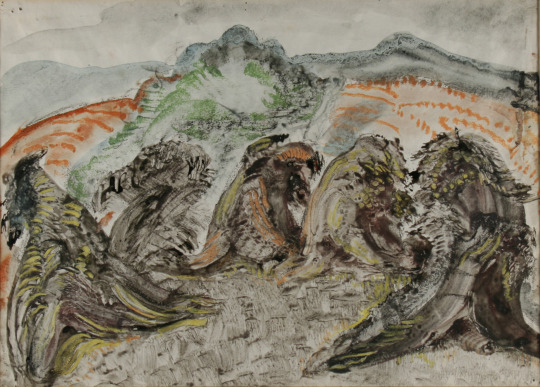
Vera Cunningham - 'Stooks',
Born in Hertfordshire of Scottish parentage, Vera studied painting at the Central School of Arts and Crafts. She began exhibiting with the London Group in 1922. With Matthew Smith, she exhibited in Paris at the Amis de Montparnasse and the Salon des Indépendants in 1922. Her first one-man show was held at the Bloomsbury Gallery in 1929. She produced a number of theatre designs at the end of the 1930s, but returned to easel painting. During WWII she was involved in the Civil Defence Artists' shows at the Cooling Galleries. After the war her Paris dealer, Raymond Creuze, mounted three exhibitions in 1948, 1951 and 1954. She lived in London. The Barbican Art Gallery held a retrospective exhibition in 1985. Her work is held in the Manchester City Art Gallery; the Guildhall Gallery, London and at Palant House, Chichester.
Cuningham modeled for and had relationships with fellow artists Bernard Meninsky and Matthew Smith.

Vera Cunningham - 'Garden Scene',
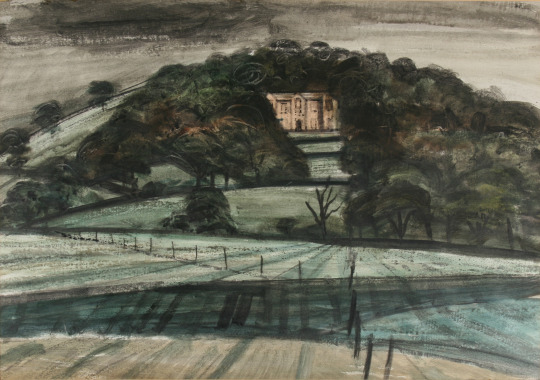
Thomas William Ward - 'Charmouth Manor'
Thomas William Ward, was born at Sheffield. Studied part-time with Eric Jones (Harold Jones's twin brother) at Sheffield 1937-1939. After service during the Second World War, Bill continued his studies at the Royal College of Art 1946-1950, winning a silver medal in 1949. He married at Kensington, London in 1949, sculptor Joan Palmer Ward. He taught at Harrow College of High Education 1950-1980, finally as principal lecturer, retiring to Suffolk in 1980. Elected a member of the Royal Society of Painter Etchers in 1953 and the Royal Society of Painters in Watercolour in 1957. This painting was bought from Whitworth Art Gallery, Manchester in 1957.

Alistair Grant - 'The Weight-lifter'
Although best known as a printmaker, Alistair Grant also painted throughout his career and in the 1980s he adopted an expressionist style using vibrant colours. He was born in London and studied at Birmingham College of Art (1941-43). After serving during the war, Grant returned to art school and the Royal College of Art, where he was taught by Carel Weight and Ruskin Spear. Grant was to work in the printmaking department of the Royal College for 35 years (1955-90), ending his career as Emeritus Professor of Printmaking at the RA.
The Weight-lifter was bought from the Whitechapel Art Gallery at their Pictures for Schools exhibition: 8 October – 29 October 1949. It is likely ‘Eva’s House’ came from a similar exhibition.
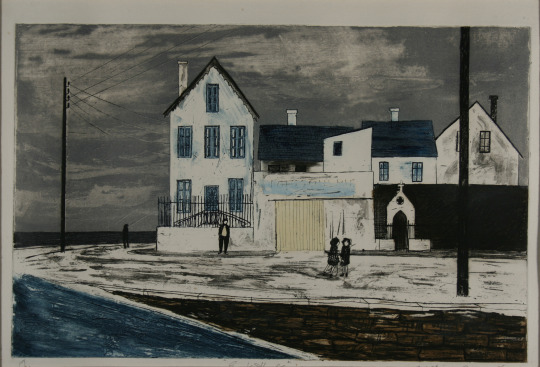
Alistair Grant - 'Eva's House', 1955

Vincent Lines - 'Old Hereford Wagon',
Vincent Lines was awarded a scholarship to the Royal College of Art in 1928. The principal, William Rothenstein described him as ‘one of the best students of the painting school’. While only in his twenties, he was appointed principal of Horsham School of Art and later became principal of Hasting School of Art. Lines was a prolific and talented topographical watercolourist, with an intimate knowledge of the countryside, which he recorded on the spot, in the open air.
He was chosen as an artist for the Recording Britain project, to which he contributed twenty watercolours. He was a close friend of Thomas Hennell and the pair often painted together in the countryside around Hennell’s home at Ridley, near Meopham in Kent.
Lines survived the war and went on to become Vice-president of the Royal Watercolour Society. He wrote the biography of Mark Fisher and Margaret Fisher Prout, illustrated Rex Waites ‘The English Windmill’
The war years brought deepened friendships in particular with Mildred Eldidge and Thomas Hennell, both fellow watercolourists of the R .W .S . Through contact with Hennell he became fascinated by country crafts and together they hunted out the potter and the cooper, wheelwright and blacksmith, hurdlemaker and charcoal burner.
During 1943-4 he painted a series of eight watercolours recording the avenues of elms in Windsor Park, before the trees were felled. The pictures are now in the Royal collection. A further commission for Vincent during these years was the contribution to Arnold Palmer’s four-volumed Recording Britain, published in association with the Pilgrim Trust.
Due to Thomas Hennell’s death in 1945 the illustration of Rex Wailes’s book The English Windmill, which would certainly have been done by him, passed instead to Vincent Lines. Wailes’s definitive survey presents English windmills in their history, construction and mode of working.
Resurgence Magazine Issue 141, Jul 1990.

Molly Field - 'Farm Implements'
Molly Field was born in Keighley, Yorkshire. She originally worked under the name Molly Clapham but then married the artist Dick Field. Attended Leeds College of Art (1932-33) then the Royal College of Art (1934-38), with Ernest Tristram. Showed at the Royal Academy, Women’s International Art Club and the Wakefield. Also known under Mary Field.
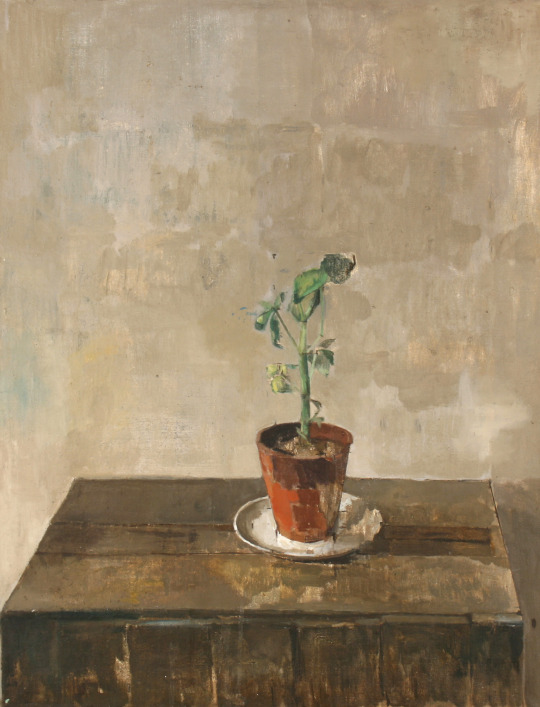
M Murphy - 'Geranium'
This is a mystery as it is one of the best paintings in the collection but there is no detail in the archives about who it is by.

Berard Gay - 'Ivy Plant'
Bernard left school at the age of 14 and after various jobs, just before the Second World War joined the merchant navy. In 1947 that he returned to education, studying textile part-time at the Willesden School of Art (1947-52) and changed course to fine-art under Maurice de Sausmarez and Eric Taylor. He began drawing classes at St Martins School of Art and quickly established himself as a painter. It may have been in the Pictures for Schools exhibition 23 January – 14 February 1954.

David Koster - 'Cat and Lilies'
Koster studied at the Slade School of Art (1944-47). Taught drawing and print-making at Medway College of Design. One-man shows at Everyman Foyer Gallery (1958, 60, 62, 64, 66, 68, 70); Glasgow Citizen's Theatre (1965); Stable Theatre Gallery, Hastings (1967). Taken several illustration commissions including work for the RSPB and a front cover for their 'Birds' Magazine.
David Koster was born in London and attended the Slade School of Fine Art from 1944 to 1947. He was a founder Member of the Society of Wildlife Artists in 1964.

Raymond Croxon - 'View in the Lake District',
Raymond Coxon enrolled at the Leeds School of Art, and the Royal College of Art. While he was there, between 1919 and 1921, he not only met his future wife but also became friends with a fellow student, Henry Moore. In 1922 Moore and Coxon visited France and met a number of artists there, including Pierre Bonnard and Aristide Maillol. Coxon continued his studies in London at the Royal College of Art between 1921 and 1925 under Sir William Rothenstein. Coxon took a teaching post at the Richmond School of Art in 1925 and in 1926 he married Edna Ginesi, with Moore acting as his best-man. Coxon would later perform the same service for Moore when he married Irina Radetsky in July 1929. He became a member of the London Group in 1931 and of the Chiswick Group in 1938.
During the WW2 he became a war artist and was commissioned to produce some paintings of Army subjects in Britain. Then working for the Royal Navy as a war artist. The painting of this print is in the collection of Palant House. The lithograph made for the Contemporary Lithographs Ltd. Other artists in the series were Eric Ravilious, John Piper, Vanessa Bell, Barnett Freedman and so on.

Julia Ball - 'East Coast Storm'
Julia Ball is a Cambridge artist and this woodcut came up for sale with the Cambridge collection of Pictures for Schools but due to a cataloguing error on the auctioneers I didn’t win it as they had labeled it as a different lot. For years I smoldered about that. But when the Hertfordshire sale came up, I had to have it. Made in the 1960s this woodcut is of a storm over the east coast. Her painting are mostly abstract and works can be found in Kettles Yard and in the New Hall art collection. This picture was bought from the Royal Academy Diploma Galleries, 1967.
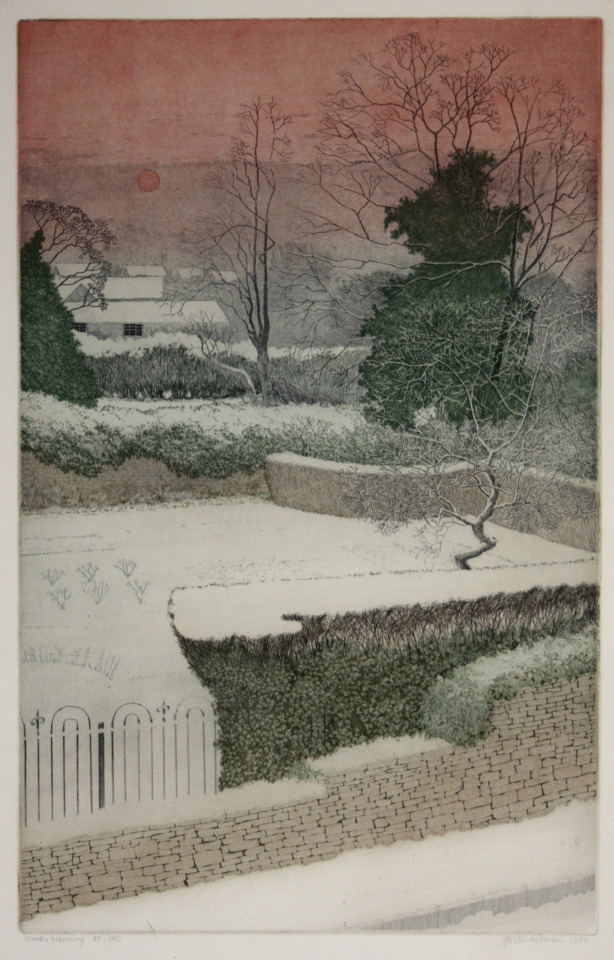
Joseph Winkelman - 'Winter Morning'
Joseph Winkelman has specialised in intaglio printmaking since 1975 after completing the Oxford University Certificate course in Fine Art at the Ruskin School of Drawing. As an active member of the Royal Society of Painter-Printmakers (RE), he served as President from 1989 to 1995 and was recently artist in residence at St John's College, Oxford.

John Sturgess - 'Black and White Leaf'
A student at the Royal College of Art in the 1950s. He would have been taught by Julian Trevelyan, Edwin La Dell, Edward Ardizzone and Edward Bawden. He worked with John Brunsdon as a printer, printing other artists work, rather than going into teaching. They set up a press in Digswell Art Centre and that is likely how his work ended up in the Hertfordshire Collection. This work of a leaf looks more like foil, it is rather beautiful and a lithograph on stone. Though I haven’t photographed it the frame is a John Jones frame made of aluminium and is as beautiful as the print.

John O'Conner - 'Boy and the Heron'
John O'Connor A.R.C.A. R.W.S, is today best known for his woodcuts, but during his lifetime he was also celebrated as a watercolourist. In 1930 he enrolled at Leicester College of Art before moving on to the Royal College of Art in 1933. His teachers at this time were Eric Ravilious, John Nash and Robert Austin. He graduated in 1937.
On a visit to Eric Ravilious’s home at Bank House, Castle Hedingham in Essex, O'Connor was captivated both by the directness of the wood-engraving technique, and by the simple domestic scene in which Ravilious engraved by a lamp in one corner of the room while his wife Tirzah played with their small son by the fire in another. It was due to Ravilious that O'Connor got his first commission of work aged 23, illustrating Here’s Flowers by Joan Rutter for the Golden Cockerel Press in 1937.
He taught at Birmingham and Bristol before serving in the Royal Air Force form 41-45. On being demobbed he illustrated two books for the Golden Cockerel Press and taught in Hastings for two years before moving to Colchester to become the head of the School of Art in 1948. He was affectionately known as ‘Joc’ to his students, using his initials. His colleagues included Richard Chopping, who designed dust jackets for the James Bond novels, his own former teacher John Nash, and Edward Bawden, one of the finest British printmakers.
He saw his favourite painting places in Suffolk - the ponds, willows, briars and honeysuckle - disappear beneath the bulldozer and combine harvester. In 1964 O'Connor retired from teaching full time at Colchester, to concentrate on painting and engraving. He wrote various 'How to’ books and taught part time at St Martin’s School of Art. In 1975 he and his wife, Jeannie, went to live by Loch Ken in Kirkcudbrightshire, where his love of light and water inspired his many watercolours and oil paintings. He took up a post teaching at Glasgow School of Art from 1977 to 1984.
In the 1950s and 60s, O'Connor exhibited at the Zwemmer Gallery, in London, and had many exhibitions throughout Britain. His work was purchased by the Arts Council, the Tate Gallery, the British Museum and the Contemporary Art Society, as well as by several local education authorities; it can also be found in the Oslo Museum, the Zurich Museum and at New York central library. He was elected to the Royal Society of Painter-Etchers and Engravers in 1947, and, in 1974, to the Royal Watercolour Society. He was an honorary member of the Society of Wood Engravers.

June Berry - 'High Meadow'
June Berry studied painting at the Slade School of Fine Art, London. She has had nineteen solo exhibitions including a retrospective at the Bankside Gallery, London in 2002. Her paintings have been exhibited frequently at the Royal Academy Summer Exhibition, London since 1952. Berry was Vice-President of the Royal Watercolour Society from 2001 to 2004.
Her work is included in the collections of HM the Queen, the British Government Art Collection, the Victoria & Albert Museum, London, the National Museum of Wales, the Royal West of England Permanent Collection, the Graphothek, Berlin, Germany and the All Union Society of Bibliophiles, Moscow, Russia. Her work has also been purchased by many private collectors in the UK, USA, Germany and Russia. She is a Member of the Royal Watercolour Society, the Royal Society of Painter-Printmakers, the New English Art Club and is a Royal West of England Academician.

Madeleine Holtom - 'Orchids'
Madeleine Elizabeth Anderson was born in Belvedere, Kent. She studied art at the Kingston School of Art where Reginald Brill was principal with other teaching from Anthony Betts, William Ware and John Platt. In 1932 she was awarded a scholarship to study at the Royal College of Art, there she won the painting prize in 1934. She painted in oils and watercolours under William Rothenstein and Gilbert Spencer.
Leaving the RCA she became a professional artist and also worked making advertisements. She married and divorced G. H. Holtom and they had two sons and two daughters, they moved to Northwood near Watford, North-West London.
She also exhibited with the New English Art Club.
Her work is represented in the collections of: Friendship House, Moscow. Queen’s College, Oxford. The Cuming Museum. Cheltenham’s Art Gallery. The Government Art Collection, British High Commission, Accra, Ghana.

Frank Freeman - 'Flower Piece',
Frank Freeman is a bit of a mystery to me at the moment. I can find mention of him in a few places but sadly due to the blitz and poor archiving many are the lost. What is known is he was supported for a while by Lucy Carrington Wertheim and he was based in the Manchester area. One flower painting is mentioned in her book Adventure in Art.
Visitors who came to see me about this time. Among these were Frances Hodgkins, who stayed for months at a time at my flat, Henry Moore and his lovely Russian wife, John Skeaping, Barbara Hepworth, Cedric Morris, Lett Haines, John Alford, William Plomer, Leon Underwood, John Gould Fletcher, Pavel Tchelitchew, Komisarieysy, David Fincham and his wife Sybil, Jim Ede and Frank Freeman.
Lucy Carrington Wertheim - Adventure in Art, 1947 p10-11

John Wynne-Morgan - 'Christmas Roses'
John Wynne-Morgan was born in Harrogate, Yorkshire and enrolled at the Heatherley School of Fine Art in London in 1945.
In a 1962 London catalogue foreword, Wynne-Morgan is described as ‘primarily a portrait painter’ (though the show contained scenes of Paris, Ibiza, Venice and London, and he also painted many Bonnard-ish nudes). His studio was in Hampstead and he was the author of three books for aspiring artists. In Oil Painting as a Pastime: A Complete Course for Beginners (Souvenir Press, London, 1959), he evokes how hard it is to embark on a portrait:

Edna Rodney - 'Parrot Tulips'
Of all the artists I bought Edna Rodney eludes me, I can not find her anywhere and it might be she was an art student who gave up art for a family or she might have been one of Hertfordshire’s pupils that ended up in the collection as sometimes happened. It is rare to find nothing however.
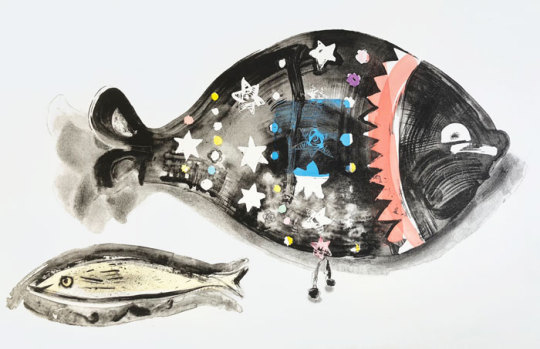
Chloë Cheese - 'Lucky Fish',
Chloëʼs childhood was spent in the Essex village of Great Bardfield observing the printmaking of her mother Sheila Robinson and she remembers in particular often visiting the studios of fellow printmakers Edward Bawden and Michael Rothenstein.
She has contributed to a recent book Bawden, Ravilious and the Artists of Great Bardfield published by the V&A. Chloë studied at Cambridge Art School from 1969 and the RCA from 1973 to 1976.
She has lived in South London since the 70s, investigating her home and surroundings first through drawing which is then used as a basis for the creation of monoprints, lithographs and etchings. Her engagement with still life subjects has widened to include figures against the palimpsest of an urban life.
Chloë has exhibited widely and her work is held in various public collections including The V and A Museum London and The Arts Council of Great Britain.
Bio via St Judes.

Chloë Cheese - 'Pink Carnations',
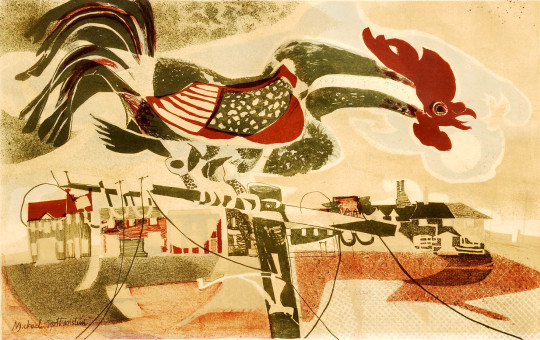
Michael Rothenstein - 'Coronation Cockerel'
Born in Hampstead, London, on 19 March 1908, he was the youngest of four children born to the celebrated artist, Sir William Rothenstein and his wife Alice Knewstub. He studied at Chelsea Polytechnic and later at the Central School of Arts and Crafts. Affected by lingering depression, Rothenstein did little art making during the late 1920s and early 1930s. Despite this, he had his first one-man show at the Warren Gallery, London in 1931.
During the late 1930s the artist's output was mainly Neo-Romantic landscapes and in 1940, like Vincent Lines, he was commissioned to paint topographical watercolours of endangered sites for the Recording Britain project organised by the Pilgrim Trust. In the early 1940s he moved to Ethel House, in the north Essex village of Great Bardfield.
At Great Bardfield there was a small resident art community that included John Aldridge, Edward Bawden and Kenneth Rowntree. In the early 1950s several more artists (including George Chapman, Stanley Clifford-Smith, Audrey Cruddas and Marianne Straub) moved to the village making it one of the most artistically creative spots in Britain. Rothenstein took an important role in organising the Great Bardfield Artists exhibitions during the 1950s. Thanks to his contacts in the art world (his older brother, Sir John Rothenstein, was the current head of the Tate Gallery) these exhibitions became nationally known and attracted thousands of visitors.
From the mid-1950s Rothenstein almost abandoned painting in preference to printmaking which included linocut as well as etchings. Like his fellow Bardfield artists his work was figurative but became near abstract in the 1960s.
Although little known as a painter, Rothenstein became one of the most experimental printmakers in Britain during the 1950s and '60s.
Rothenstein was elected an Associate of the Royal Academy (ARA) in 1977 and a Royal Academician (RA) in 1984. Near the end of his life there was a retrospective of his work at the Stoke-on-Trent City Museum and Art Gallery (1989) and important shows followed at the Fry Art Gallery, Essex.
The print I have (The Cockerel) was made for the Festival of Britain series of prints in 1951 and is signed under the mount. Likely bought from Redfern Galleries.

My blog of some of my pictures from the Cambridgeshire Collection of Pictures from Schools is here.
For areas of research I am indebted to Catherine Davis and Natalie Bradbury.
#Michael Rothenstein#Chloe Cheese#Pictures for Schools#Vera Cunningham#Alistair Grant#Vincent Lines#Molly Field#Berard Gay#David Koster#Raymond Croxon#Julia Ball#John O'Conner#Madeleine Holtom#Frank Freeman#John Wynne-Morgan
2 notes
·
View notes
Text
My media this week (5-11 May 2024)
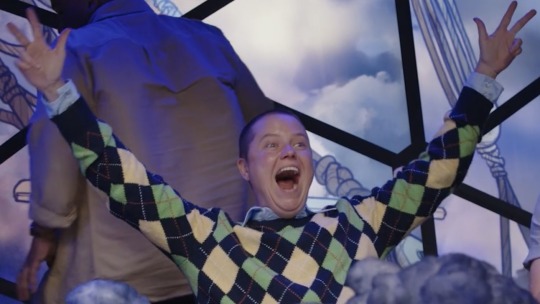

another absolutely unhinged episode from this crew. i love them all so much.
📚 STUFF I READ 📚
🙂 Lessons in Exposing a Deadly Alias (Cambridge Fellows Mysteries) (Charlie Cochrane) - this series is now the equivalent of watching criminal minds or some other long-running procedural: it's certainly not for the plot/mystery but for the characters who are family. I do love that as the series has gone on their friends & family have taken on a more active role in the investigations. that said, I think I might be done with this series; it took me forever to get thru this bc I wasn't remotely motivated to get back to it.
🥰 No One Likes Us But We Don't Care (Rainne) - 45K, modern Steve/prewar Bucky - an accidental interdimensional swap drops a 1940s Bucky into the present - he & Steve figure out what that means for them (3rd in a series)
😍 Spectred Isle (Green Men #1) (KJ Charles, author; Ruairi Carter, narrator) - [reread] very old world supernatural shenanigans in 1920s England - truly sad that there won't be any more in this universe because it's sooooo good and so rich but forever grateful we at least got this marvelous (and complete) story
🥰 it's good to see you back in a bar band, baby (LiarsandThieves22) - 139K, Steddie modern musician AU - absolutely adored this! enemies-to-friends-to lovers speedrun, understandable & character appropriate mutual pining, fantastic supporting characterizations - it had it all!
😍 You Should Be So Lucky (Cat Sebastian, author; Joel Leslie, narrator) - baseball player Eddie & newspaper writer Mark are both dealing with some devastating life events. They find each other and some solace and healing. This book, like We Could Be So Good, is absolutely incredible. It knocked my socks off and healed my heart. It almost made me like baseball! I'm just going to quote from a review written by kiki124 in the Romance Salon server because she is great with words and captured it exactly: "I was just blown away by the writing and the ways Sebastian drew these two utterly believable and interesting characters, plus all the side characters, plus the literary notes, plus the queer history plus the New York history. I think that what I love the best about these books is that the story doesn't end when the characters fall in love--there's a whole second half of the book to come as the relationship has room to breathe and grow and work out kinks. Literally everyone who has a heart and a brain should read these books."
💖💖 +115K of shorter fic so shout out to these I really loved 💖💖
the Steve Rogers problem (relenafanel) - MCU: stucky AU, 36K - "Bucky doesn't consider his Steve Rogers problem as a problem so much as the solution he hadn't realized he was hoping for to help him through the transition from the Bucky Barnes he'd been before his accident to the new, shiny version of himself. No, the problem isn't with Captain America and The Howling Commandos fandom. The problem is the amount of porn Bucky managed to write and draw about Captain America before finding out that he's less than one degree of separation away from Steve Rogers. 'Less than' as in he's sitting across the table from him."
📺 STUFF I WATCHED 📺
Is It Cake? - s2, e4-5
Girls5eva - s1, e1
QI - series U, e4-8
Beyond Paradise - s2, e4-6
Game Changer - s6, e8
Strange Way of Life (2023)
Um, Actually - s6, e6
The Brokenwood Mysteries - s10, e2
Smartypants - s1, e2
D20: Fantasy High: Junior Year - "Rock The Boat" (s21, e18)
D20: Adventuring Party - "Blimey" (s16, e18)
Doctor Who - series 14, e1-2
🎧 PODCASTS 🎧
Re: Dracula - May 5: The Dead Travel Fast
Wiser Than Me - Julia Gets Wise with Patti Smith
The Atlas Obscura Podcast - Sans-Souci Palace
Wait Wait… Don't Tell Me! BONUS - The animal that terrifies Peter, and other 'Wild Card' topics
Re: Dracula - May 7: Stranger in a Strange Land
Short Wave - 'Stealing The Past': A Spat Between Twins Leads To A Theory Of Disputed Memories
Re: Dracula - May 8: Foul Bauble of Man's Vanity
Vibe Check - Oh, How We Have Fallen From Taste
Re: Dracula - May 9: Castles in the Air
Today, Explained - Israel, Gaza, and Eurovision
Consider This from NPR - From utility man to one of California's foremost journalists
It's Been a Minute - A 'Wild Card' game with Rachel Martin
Wild Card with Rachel Martin - Issa Rae thinks a little delusion goes a long way
⭐ It's Been a Minute - Drake and Kendrick are beefing, but who pays? Plus, moms as our social safety net
Today, Explained - The real victims of Baby Reindeer
Re: Dracula - May 11: Pray for my Happiness
Twenty Thousand Hertz+ - TikTok’s Boom-Bling
⭐ Lost Notes - Go with the Flow: Community, Virality, and the Politics of Dancing
Why Won't You Date Me? - Love in Theater (w/ Jesse Tyler Ferguson)
Wait Wait… Don't Tell Me! - Chappell Roan
⭐ Big Gay Fiction Podcast - Baseball, 1960 New York, and Bad Dogs with Cat Sebastian
The Atlas Obscura Podcast - Beauly Priory Wych Elm
🎶 MUSIC 🎶
'60s Sunshine Pop
'60s Folk Rock
Dance Party Hits
Carly Rae Jepsen
Presenting Charli XCX
Presenting Dua Lipa
Energy Supermix
Women of Electronic
Essential Proto-Metal
Rock Radio • 1980s • Popular • High variety
Presenting The Beach Boys
Classical Workout
Instrumental Hard Rock
#sunday reading recap#bookgeekgrrl's reading habits#bookgeekgrrl's soundtracks#fanfic ftw#cat sebastian#kj charles#dropout tv#british comfort murders#'60s music#carly rae jepsen#dua lipa#charli xcx#the beach boys#'80s music#big gay fiction podcast podcast#lost notes podcast#it's been a minute podcast#re: dracula#20k hz podcast#vibe check podcast#the atlas obscura podcast#wait wait... don't tell me!#today‚ explained podcast#wild card podcast#consider this podcast#short wave podcast#wiser than me podcast
5 notes
·
View notes
Text
Brittany Kaiser’s work with Cambridge Analytica helped elect Donald Trump. She’s hoping the world will forgive her.
https://www.washingtonpost.com/technology/2019/08/02/brittany-kaisers-work-with-cambridge-analytica-helped-elect-donald-trump-shes-hoping-world-will-forgive-her/
Brittany Kaiser’s work with Cambridge Analytica helped elect Donald Trump. She’s hoping the world will forgive her.
By Craig Timberg and Rosalind HELDERMAN | Published August 02 at 1:13 PM ET | Washington Post | Posted August 2, 2019 7:40 PM ET |
Brittany Kaiser first emerged in last year’s Cambridge Analytica scandal as a seemingly nefarious figure, an insider steeped in the dark secrets of a new kind of voter manipulation powered by Facebook data. To make matters worse, news reports also raised questions about Kaiser’s mysterious dealings with WikiLeaks mastermind Julian Assange at a time when he remained holed up in the Ecuadoran embassy in London.
For Kaiser — at the time a 30-year-old Democrat from Texas who’d become business development director for Cambridge Analytica, a firm created to elect Republicans — the massive wave of critical news reports about the company threatened to deliver catastrophic damage to her reputation and even made her fear possible arrest.
So she did something drastic: Kaiser fled to Thailand, and she let a crew of filmmakers tag along.
What followed was a highly public — and still unfinished — quest for moral redemption that has played out across the globe and, now, in a Netflix documentary called “The Great Hack,” released July 24. It includes images of Kaiser up to her shoulders in a giant pool under an impossibly blue sky in Thailand, uncertain what to do. And it later depicts Kaiser, in a far more determined frame of mind, testifying before the British Parliament about the many unsavory deeds of her former employer and warning of the ongoing privacy threats posed by Facebook, whose dealings with Cambridge Analytica resulted in July in more than $5 billion in U.S. fines.
But two important elements are missing from the film. The first is Kaiser’s private meetings with British and U.S. prosecutors, including those from then-special counsel Robert S. Mueller III’s office, which she recently detailed in interviews with The Washington Post. In these she also explained her visit with Assange in 2017 and how close she came during the hottest days of the Cambridge Analytica scandal to turning over the entirety of her hard drive to WikiLeaks for publication online.
The second missing element is a decisive moment of reckoning for Kaiser, during which she fully acknowledges her role in matters she now regards as wrong and possibly illegal. She repeatedly calls herself a “whistleblower” but viewers of the film may wonder: Why didn’t she blow the whistle a little sooner — ideally before Cambridge Analytica’s misdeeds had become front-page news worldwide?
It’s a question, Kaiser told The Post, that she still struggles with herself.
“I used to make so many excuses to myself,” she said. “I used to make excuses to my friends and family on why I was there and that it was okay to be working with these people and that what they were doing wasn't all that bad, and I was just doing my job. I look back at some of it, and it's shocking.”
Kaiser’s efforts to wrestle with this legacy in such a profoundly public way shoots a charge of emotional electricity through a film otherwise devoted to distinct heroes and villains. She occupies a middle ground of moral complexity while she seeks to emerge from what she now depicts as a fever that consumed more than three years of her life.
“She knew before the story blew up that the rights of Americans had been violated,” said David Carroll, an associate professor of media design at the New School in New York and a hero in the film for his dogged legal battle to gain access to the data Cambridge Analytica had collected on him. He is among those who would think better of Kaiser had she spoken up about her qualms with Cambridge Analytica before the scandal erupted.
“Once that’s out, it’s hard to be a whistleblower,” Carroll said. “You’ve missed your chance.”
But whistleblower or not, Kaiser’s story is a compelling one for the insights it offers into the dark heart of Cambridge Analytica, the unregulated market for our personal data and also — and perhaps most importantly — what happens when questionable decisions get thrust to the center of the world’s white-hot gaze.
A JOB OFFER IN THE U.K.
Kaiser was a graduate student in international human-rights law at Middlesex University in London when she met Alexander Nix, the now-disgraced chief executive of Cambridge Analytica. The company had been created by Republican strategist Stephen K. Bannon, who served as the company’s vice president, with money donated by conservative financier Robert Mercer. And while the parent company, called SCL Group, meddled in elections across the world, Cambridge Analytica had a more specific brief — to use the emerging science of Big Data to help Republicans win U.S. elections.
Like the company’s well-known whistleblower, Christopher Wylie, who helped British journalist Carole Cadwalladr of the Observer expose Cambridge Analytica’s misdeeds, Kaiser was no conservative. She had dabbled in Democratic politics and at one point had aspired to work for Hillary Clinton’s campaign in 2016.
Nix, who appears in the film and in much of the news coverage as a particularly skilled manipulator of his fellow humans, lures Kaiser to join his company with the unforgettable line: “Let me get you drunk and steal your secrets.”
Kaiser, whose parents suffered serious financial troubles that led to the loss of their home the same year she started working at Cambridge Analytica, appears to fall hard for the unmistakable scent of money and power that wafts through the conservative political world Kaiser soon inhabits. The film shows her in a series of exotic locations, dressed in pearls with a champagne glass in hand and on shooting weekends with her new associates. During this phase, she even joined the National Rifle Association, a group seemingly at odds with her traditional political views.
“The Great Hack” also details how Cambridge Analytica gathered up data on a massive scale, using an online app to collect information on tens of millions of Facebook users — everyone who used the app and all of their friends — and also from data brokers. The goal was targeting them with messages designed to work on voters’ underlying psychologies. Perhaps the most appalling moment in the film comes as SCL Group orchestrates a voter suppression campaign in the Caribbean nation of Trinidad and Tobago that succeeds in helping a candidate of South Asian descent triumph when poorer, darker-skinned supporters mysteriously fail to cast ballots.
SCL Group reportedly also had a role in an operation in Nigeria in which an Israeli firm obtained private emails from that nation’s president, Muhammadu Buhari, when he was a candidate for office in 2015, according to Cadwalladr’s reporting that also tied Kaiser to the effort. (The article appeared in the Guardian, the sister paper of the Observer.) Those emails, like those of Democrats working to elect Clinton in 2016, mysteriously emerged online during the election season, hurting Buhari’s candidacy. Kaiser told The Post that she won the account for SCL but did not have a direct hand in the collecting or deploying of the emails.
But these events have kept Cadwalladr from regarding Kaiser’s efforts to redeem herself as entirely convincing, especially given that Kaiser decided to flee to Thailand shortly after the article about SCL’s meddling in Nigeria appeared, naming her. “I think it’s hard to know if she’s sincere or not because of the circumstances in which she chose to blow the whistle: the day after we revealed her role at center of particularly problematic election,” Cadwalladr said in an interview.
Kaiser has repeatedly portrayed her actions after leaving Cambridge Analytica as well-intentioned, driven by rising revulsion at the things she’d witnessed and a determination to speak out — classic whistleblower motives. Now that some official investigations are wrapping up, Kaiser says she’s eager to tell the full story. On Tuesday, Parliament released new documents that she had furnished on Cambridge Analytica’s role in the early days of the Brexit campaign, underscoring the importance of her cooperation.
That all of this coincides with the release of a largely sympathetic film and a Kaiser memoir, to be published by HarperCollins in October, only makes Cadwalladr warier — though she also praised Kaiser for providing evidence to authorities and said she wished others from Cambridge Analytica would follow Kaiser’s example.
“The problematic thing for me is her monetizing and exploiting this role, essentially,” Cadwalladr said. “There is this sort of hero-ization of her as a character, and that’s tricky given the many important still-unanswered questions.”
A MOMENT OF CLARITY
Kaiser said she began turning away from Cambridge Analytica and its sharply conservative, Fox News-driven world the night of Trump’s victory, which came as both a surprise and a shock to her political and moral sensibilities. For all of Cambridge Analytica’s claims about the power of its precise voter targeting, nobody knew how well it would work in the U.S. presidential election.
“I was then, like, ‘Wow, I was part of something that I shouldn't have been part of. I never thought that the campaign is actually going to win. Oh my God.’ He actually won through this, you know, racist, sexist rhetoric that has divided a country that was actually doing quite well,” Kaiser said.
Soon after, she found herself in a conflict with her bosses over her role in the company. A promotion she sought to Cambridge Analytica’s executive ranks didn’t come through. A hoped-for job in opening the company’s offices in Mexico City went to somebody else — a man — reactivating her feminist sensibilities.
“That's when the disillusionment really sunk in. And I realized these people could be doing a lot more than I know about, because they're cutting the corners that I see, and I'm not an executive of the company. So what else is going on?”
This dawning realization, however, was gradual enough that Kaiser still found herself hobnobbing around victory parties the night before Trump’s inauguration in January 2017. She dropped by one hosted by Britain’s Brexiteers and even made what she said was a brief appearance at the Deploraball, an event including members of what was then called the alt-right, who reveled in the strident, racially charged rhetoric of Trump’s campaign.
Inside the event, Kaiser said, she recoiled at a painting of George Washington wearing a red “Make America Great Again” hat.
“It was so offensive,” she recalled. “I went in there. I recognized some of the people around. Once I got inside and recognized some of the people that were there … I had to leave.”
She watched the inaugural the following day, at another party, atop the W Hotel overlooking the White House with a cocktail in her hand.
A MEETING WITH JULIAN ASSANGE
The event that would make Kaiser herself newsworthy happened a few weeks later, in February 2017.
She had a long-standing admiration for Assange and, in 2011, had donated about $200 worth of bitcoin to the group in honor of its work revealing a secret trove of U.S. military files related to the Iraq War. Kaiser had cited its work in her master’s thesis on war crimes.
But what ultimately brought Kaiser and Assange together was the death of well-known human rights lawyer John R.W.D. Jones, who was hit by a London train in an apparent suicide. Kaiser considered Jones, who had represented Assange, a mentor. When a mutual friend suggested that Kaiser and Assange meet to commiserate, she agreed in concept but was unable to arrange a meeting quickly. The Jones death happened in April 2016, as Cambridge Analytica’s campaign work was accelerating. In the aftermath of Trump taking office, with Kaiser increasingly questioning her life choices, the idea of meeting Assange gained traction.
But first she had to get through Assange’s gatekeeper, a gray-haired British man whom she knew only as “James.”
He and Kaiser met over tea at Harrods, the iconic London department store. The next day Kaiser visited with one of Assange’s lawyers for a second round of vetting. The third day, Kaiser, in the morning before heading to work at Cambridge Analytica’s London offices, walked up to the Ecuadoran Embassy, suddenly aware that she almost certainly was being watched, her name entered into the files of at least one government’s intelligence agency.
She also entered with full knowledge of the allegations that Assange had worked with Russians in manipulating the U.S. election but, at the time, dismissed the claims as hyperbole.
“All of this, to me it sounded, I hate to use the term, but it just sounded like ‘fake news.’ It sounded like a way to discredit what could have been credible information,” Kaiser recalled. “And so, unfortunately, the information bubble that I was in, actually being surrounded by Republicans and being surrounded by conservative messaging all of the time, looking back on it, I realized I was a lot more affected than I would have liked to believe at the time.”
By this point, Assange had been in the embassy, avoiding arrest, for more than four years and would be there for two more before authorities rousted him this past April. Kaiser, encountering him for the first time, was immediately struck by how pale he was — somehow paler even than the white, buttoned shirt he was wearing.
Yet despite his appearance — and a rambling conversation she recalled as mainly devoted to Assange monologues on several geopolitical subjects — Assange mustered enough charisma to calm Kaiser’s rising unease about the role Cambridge Analytica had played in electing Trump. Assange assured her Trump was a better choice than Clinton would have been, referencing some of the decisions she had made as secretary of state. “The one who didn’t have blood on his hands won the election,” Assange told her, according to her recollection.
The comment succeeded in soothing her, at least for a time. “I kind of viewed that as, well, Julian knows more than I do,” Kaiser said. “So maybe I should be calm about that.”
FLIGHT TO THAILAND
But Kaiser was decidedly not calm, more than a year later, when the Cambridge Analytica stories broke in the Observer and the New York Times, triggering a global scandal. A few days later came the story, under Cadwalladr’s byline, about the SCL operation in Nigeria and Kaiser’s role in landing the contract.
James, her WikiLeaks contact, messaged that same day, through an encrypted app, wanting to talk, she said.
She was visiting San Francisco at the time and getting worried that authorities in both the United States and England might be looking to talk to her. She knew a lot about the role Cambridge Analytica had played in Trump’s election and also in the first phases of the Brexit campaign. But she wasn’t sure the official inquiries would be friendly. With the possibility of arrests in the back of her mind, Kaiser headed to the airport and off to Thailand for an unplanned vacation.
Kaiser agreed to meet with James a few weeks later when she was back in London, feeling a bit less in immediate peril.
In this second meeting, James made an intriguing offer: Why not turn over her laptop computer for publication online so that journalists, investigators and anyone else searching for the truth could simply crawl their way through the data and reach their own conclusions? Kaiser was desperate to clear her name. James said this was the best way to do it.
“He said, ‘Well, we can help you with that, but we publish indiscriminately,'” she recalled James saying. “'Nothing will be held back. Nothing will be redacted. We’ll publish the entire thing. Your whole hard drive.'”
So tempted was Kaiser by this offer that she made arrangements to take that step remotely — from wherever in the world she happened to be when she made the decision.
“I left a copy of my computer in London in a safety deposit box,” Kaiser recalled. “I had trusted people that had the password. And I knew that if I did make the decision, that someone in London would be able to pass it” to James and WikiLeaks.
And this is where the filmmakers, having trailed her all the way to Thailand and back, played a crucial role.
TELLING HER STORY
The team behind “The Great Hack” are Jehane Noujaim and Karim Amer, a married couple who already were working on a film on the dangers of modern technology when the Cambridge Analytica story broke, giving them an ideal frame for telling the story. They found Kaiser quickly upon her emergence in the coverage, and it was Amer who put her in touch with a contact he knew at the FBI.
That connection, which eventually brought her into contact with Mueller’s investigation and other ones in the United States, ultimately provided the most convincing act of redemption in Kaiser’s story.
“Her story is one that’s about power, about how power seduces and how power shapes us,” Amer said.
What he finds redemptive is the decision, however belatedly, to speak up.
“She didn’t need to do any of the things she did” in cooperating with authorities and the film. “She could have just walked away into the wilderness and never been heard from again, like so many people did at Cambridge Analytica.”
Kaiser sat for many hours of interviews with Mueller’s staff, as well as joint visits with investigators for the FBI, Securities and Exchange Commission and Federal Trade Commission. Kaiser talked about Cambridge Analytica. She talked about Facebook. She talked about WikiLeaks and meeting with Assange and the donation. She even gave investigators the number she had for James, which she presumed no longer worked.
The FTC and the SEC together levied more than $5 billion worth of fines against Facebook, and the FTC also sanctioned Cambridge Analytica’s Nix and the app developer from whom Cambridge Analytica bought the Facebook data. The British Information Commissioner’s Office, meanwhile, is in the final phases of a year-long investigation, with the help of Kaiser and others. She also turned over her laptop computer to U.S. investigators — and not to WikiLeaks — along with hundreds of thousands of emails and other documents.
Cambridge Analytica, meanwhile, dissolved in infamy.
The extent of the danger to Kaiser was underscored not long after she first established contact with the U.S. authorities. Another article came out — again by Cadwalladr — about Kaiser’s meeting with Assange.
The story was not a flattering one, and Kaiser disputes the characterizations in it, if not the basic facts. The article reported that Kaiser and Assange met “to discuss what happened during the US election” and that Kaiser claimed to have “funneled money” to WikiLeaks.
In her interviews with The Post, Kaiser said the election barely came up in her one meeting with Assange and the only thing that may have qualified as “funneling” was the bitcoin donation in 2011, before Cambridge Analytica was founded.
Cadwalladr, in speaking to The Post, said of Kaiser’s criticisms, “We sent her a formal right to reply which set down specifically and in detail what we knew and were planning to say and gave her the chance to respond and she didn’t. We therefore based the story on what we knew. We updated it later to reflect her later statements.”
All of which brings back the question of Kaiser’s reputation, which she has worked so hard to rehabilitate. What of it now?
Kaiser wants to be remembered more for what happened after Cambridge Analytica imploded — for working with investigators and, in the interest of not disrupting investigations, holding her tongue on sensitive matters until they could conclude their work. Some questions about her actions, she said, would have been clearer sooner if she had felt free to speak out. That was part of the price of working with authorities, she said, and that price was worth it to her.
“I definitely made the right decision,” Kaiser said. “A lot of the investigations are still ongoing. So I’m really hoping that we’re going to have a result where if people did commit crimes, that they are held to account. As of right now, there are multiple people that I think should be held to account that haven’t yet, and so we’ll see where that goes.”
As for what happened before, she sometimes speaks as if it were another person — or another version of herself — that fell so deeply into a world she now openly despises. The fever, she knows, held her far longer than it should have.
“It started to break down gradually,” she said. “I’m sad that it took me so long to erode this outer shell that I had developed from working there.”
If that falls short of the abject apology that some viewers of “The Great Hack” may crave, she offered this in her interviews with The Post:
“I’m incredibly sorry about letting the wool be pulled over my eyes,” Kaiser said. “I think of myself as intelligent and strong and principled. And look what happened. If it happened to me, it could happen to anyone.”
#politics#u.s. news#donald trump#trump administration#politics and government#president donald trump#trump#white house#us: news#international news#republican party#republican politics#must reads#trump scandals#national security#maga#world news#democrats#democracy#tech#tech news#technology#Cambridge Analytica#u.s. presidential elections#elections#2020 candidates#2020 election#2020 presidential election
2 notes
·
View notes
Text
I finally gave the backstories for my OCs!
It’s big, so I’ll post it below the cut!
Cristina Elaine MacCready, formerly Howard, nee Montgomery
Cristina Elaine Montgomery was born in 2052 and grew up in Cambridge, Massachusetts. She was the second child and only daughter of Adam Charles Montgomery and Fiona Dawn Montgomery. She is three years younger than her brother, Archer James Montgomery.
All throughout her life, she was verbally, emotionally, physically and even sexually abused by her father, although Archer protected her from as much of it as possible. Her mother was too weak and sickly to ever fight against her husband, a fact that made her take her own life when Cristina turned 15 (2067). A few days later, Archer—then 18—decided to leave for West Virginia. The two siblings argued for hours, causing a rift between them. Cristina declared she hated him and never spoke to him again. A year later (2068, age 16) she ran away from home and moved in with a couple of older friends.
After graduating from high school, Cristina fell into a slump, and became depressed. She was hospitalised at the age of 19 (2071) for attempting to take her own life, and in hospital is when she met her first husband, Nathan ‘Nate’ Howard. She dated him for about six months (which was difficult when he was fighting in the battle for Anchorage) before they were engaged. At the age of 20 (2072) Cristina decided to go ahead and get her degree in Law, supported by her fiancé, and she excelled. At 23 (in 2075), she married Nate and moved to the sleepy little town of Sanctuary Hills.
In 2077 (25), she gave birth to her and Nate’s son, Shaun Howard after he returned home from the Anchorage War. In October of that same year the events of Fallout 4 occur.
General Nuke Garvey, formerly T7-86
Nuke Garvey was created in the Institute 2 years before Cristina left the vault. His first year of life was filled with escape attempts, one of which nearly killed him when he was shot in the head by a laser rifle. He earned a burn from it forever. His final one was successful, but he was thrown into the middle of the Glowing Sea, landing right in the middle of the crater.
Since he was immune to radiation, and he came from nowhere, he was considered a gift from Atom and ended up joining the Children of Atom. For a year, he was devout, but two months before Cristina left the Vault he left the Children, stopped practicing, and wandered the wasteland. A week after Preston is saved by Cristina, he meets Preston and decides to help the Minutemen, eventually becoming the General and falling in love with Preston as well.
Laurie Melissa Anders
Laurie was born in 2258 to Hayley and Johnathan Anders, their only daughter. As a little girl she grew up in a small settlement that is no longer on the map, north of Diamond City. When she was 10 years old, in 2268, Raiders burned her home settlement to the ground and killed everyone. She only survived by hiding under the bodies of her parents after gunshots killed them through the walls of their shacks. She left the settlement after three days of hiding, when she could be sure she would not encounter the Raiders again.
This event would cause her to grow up distrustful, angry, and hateful. At the age of 12 (2270) she became addicted to Med-X, as it was the only thing that helped with the emotional pain of losing her family. In 2274, at 16, she built her characteristic Flamer, painted it blue, and called it Frostbite. While she was terrified of fire she decided to weaponise her fear and burn the Raiders as they’d burned her home. That same year she began to actively hunt Raiders down and kill them.
In 2287, Laurie—having earned a reputation of being a stone cold, aggressive, bloodthirsty ‘pyrobitch’—meets Cait, and she’s the first person Laurie can trust. They have a few sparring matches when they first meet, initially not trusting the other, but after Laurie helps Cait with her addiction (knowing what it’s like to be hooked on something) they grow closer.
Arden Boone, nee Grace
Arden Grace is the biological child of Eden of the Wastes and ex-Paladin Morgan O’Hara, and was born in 2260. Days after her birth she was left on the doorstep of Carey Grace, her adoptive parent, when her adoptive brother Daniel was six. Her mother died of severe radiation poisoning only a few miles outside the tiny settlement. Carey found the body and knew it to be Arden’s mother, but didn’t recognise the face as it had been mutated by the radiation. As a result, he made sure Arden had a ritual; she would leave a particular flower floating in water, as it was a flower she’d been left with.
Growing up, Arden was not the most intelligent person in the world, and several of the other kids in the settlement bullied her relentlessly for it. She never lost her happy-go-lucky attitude, but she does withdraw if anyone calls her dumb (or some variation thereof) because of the bullying.
When she turned 18, in 2278, she left the settlement alongside her brother and parent, and they all went their separate ways. She got work as Courier Six for the Mojave Express, and saved up enough caps to live comfortably if she wanted to. Unfortunately, in 2281, she was shot in the head by Benny for refusing to give up the Platinum Chip.
Daniel Grace
Daniel Grace is a travelling doctor, born in 2254 and adopted by Carey when they found him alone in a settlement as a newborn baby, in 2260. He was unharmed and cheerful in mood despite being alone, healthy too, so Carey took him in and raised him as best they could.
As a boy, Daniel was incredibly intelligent, and often defended his younger sister from her bullies. He began to read as many pre-war texts as he could and learned how to perform complex medical tasks when he was 17 (in 2271) and was acting as the doctor for the small settlement by 2272 (at 18).
At some point after his family left their home in 2278, he went to the Mojave and aided them, becoming a trusted ally to the Followers of the Apocalypse. Around 2281, he was working with them to find ways to mass-create medications (such as non-addictive painkillers and pre-war antiseptics).
Carey Grace – Phoenix
When human, Carey Grace was a strange person. Their birthdate is unknown, but they arrived in the small settlement they ended up living in in 2241. They made themselves known there as a trustworthy, friendly person who helped wherever they could. It was here they befriended Eden of the Wastes, but she left in 2246.
In 2260, while out exploring and searching for medicinal herbs, they stumbled across a small boy called Daniel. He was wriggling in a woven basket, with nothing but a name tacked onto his wrappings, and Carey took him in after working out that there was nobody coming for him, raising him as best they could. Six years later, a tiny infant—Arden—was left on their doorstep, with a name, a letter pleading for Carey to raise the baby, and a special flower. Carey, ever so caring, took the infant in and raised her alongside Daniel.
In 2278, Carey and their two children left the settlement, going their separate ways. In 2279, Carey arrives at the Commonwealth Wasteland, and is captured by Coursers. They take them to the Institute and they are given over to the Institute’s Super Mutant program.
What happens in between is still a mystery, but Phoenix only remembers waking up in the middle of nowhere, confused and scared. They are in incredible pain all the time and the first day they emerged in the wasteland they tried to seek help, but were shot at and nearly killed. As a result Phoenix lives in a cave on a cliff. The settlers nearby know they exist but they leave them be, because Phoenix defended them once and made it know they’re not a threat.
Phoenix now lives out their days trying to work out what happened to them, what they once were, WHO they once were.
Archer James Montgomery
Archer was born in 2049, the first child and the son of Adam and Fiona Montgomery. He was subject to abuse from his father for not being ‘manly’ enough, since he preferred to read and was a quiet young boy, rather than loud and sporty. He tried to protect his sister, Cristina, from as much of it as he could, and the events left him with undiagnosed post-traumatic stress disorder.
In 2067, at 18 years old, Archer moved to West Virginia after his mother’s death. The decision caused his sister and him to fight, and she declared her hatred for him, so he never contacted her again. In 2069, at 20, he became a bouncer for a nightclub and ended up being recruited by Vault Tec in 2070 (21) for their Vault program. In 2076 (27) the Vault closed, and Archer spent the next 25 years inside, keeping the peace for the Overseer. In those years he was promoted to security chief.
In 2102, Vault 76 opened. Archer, now 53 years old, was the last resident to leave the Vault. He explored Appalachia a bit, hunting for cryptids—as something he had wanted to do before entering the Vault—and helping his fellow Vault Dwellers out. But after launching the nukes in early 2103, Archer was heavy-hearted and abandoned Appalachia, instead trekking the United States and finding every Vault he could, learning about them, taking information from Vault Tec and destroying all but one copy.
15 years after this, in 2118, Archer had just arrived at the Commonwealth after learning his sister had been sealed in a Vault. But before he’d managed to get there, he was shot by an Institute synth. At the age of 68 Archer recorded a series of holotapes for his sister, managed to hide the information he’d collected in a secure location, and bled to death.
#fallout#fallout new vegas#fallout 4#fallout 76#oc talk#oc: cristina howard#oc: nuke#oc: laurie anders#oc: archer montgomery#oc: arden grace#oc: carey grace#oc: phoenix#sai talks#sai writes#word barf#courier six#sole survivor#female sole survivor#vault-tec#hello yes i am anxious but im still trying
10 notes
·
View notes
Photo
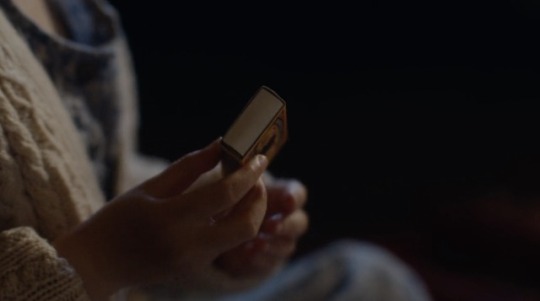
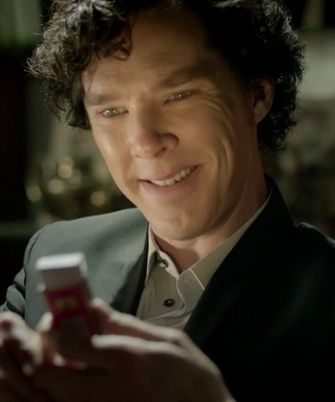
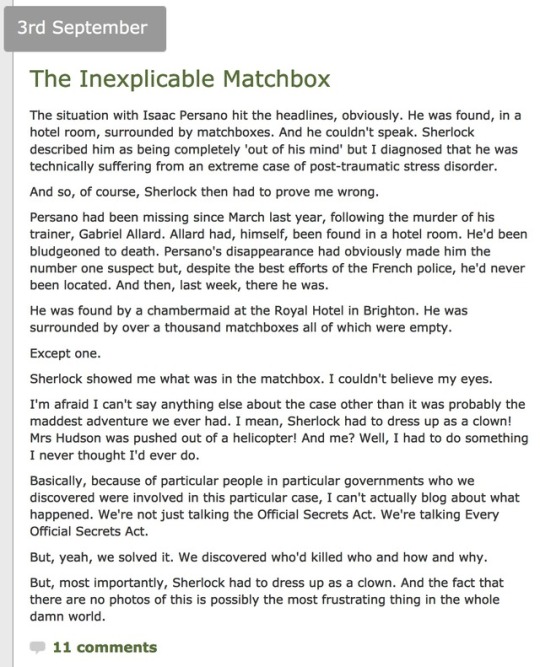
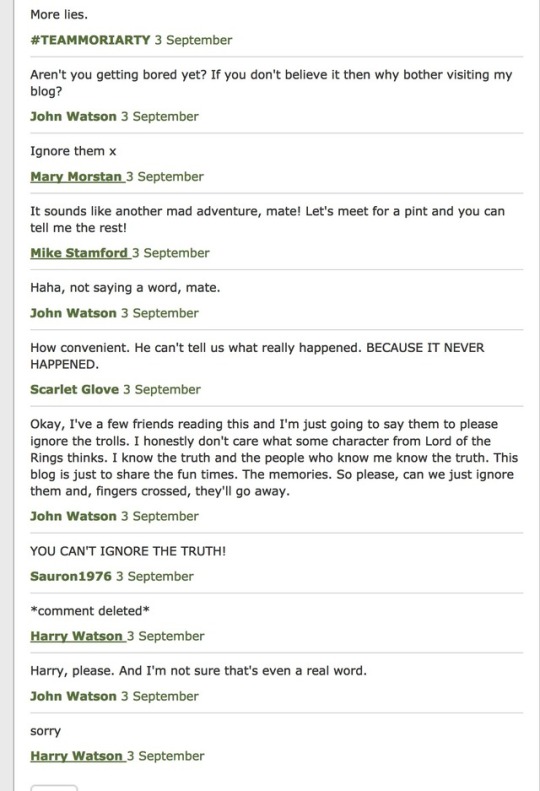


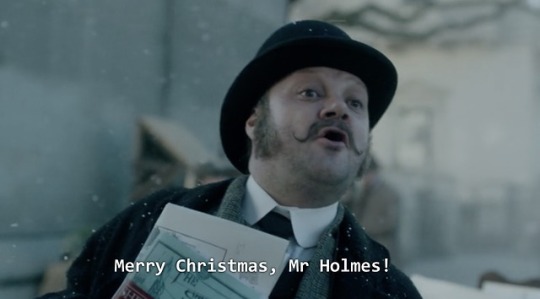
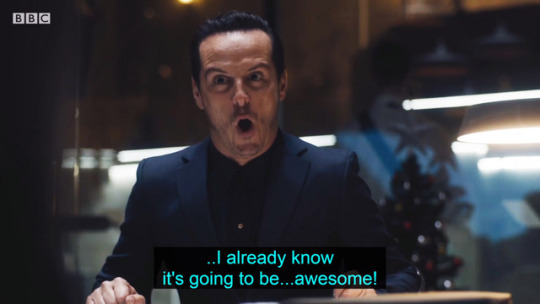
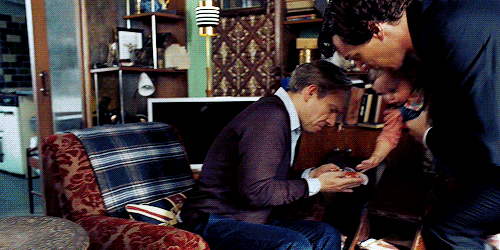
Gatiss, Lucifer Box, and Christmas
Several of us have done metas about the recurring issue of Christmas in Sherlock, so that we appear to be drawn back to either the five years prior to Sherlock meeting John, and/or the Christmas events in ASiB. At the end of TLD, if Sherlock really is having a birthday (the Day of Epiphany, with King cake that includes a baby in it), then Christmas would have just taken place, again.
In John’s blog entry, the victim has PTSD. He’s incapable of speaking, and there are the clowns, helicopter-jumping Mrs. Hudson, and John doing something he thought he’d never do--but doesn’t explain. S4 in a nutshell, except we still don’t know that that thing is that John did (other than break the fourth wall by referencing LoTR to a user that has a name to the evil light character in that series).
Sherlock continues as a savior figure in S4. It’s possible that he and John finally ‘hooked up’ and he becomes John’s soldier in preparation for TFP. Even the end of TFP involves repeats of dialogue from ASiP and TEH.
We’ve drawn correlations between Moriarty, the Devil, Sherlock, and both being Lucifer “the light-bringer” as opposed to John, the “conductor of light”. We’ve done the same with Eurus being Sherlock’s emotional side, which changed five years ago, after her visit from Moriarty at Christmas.
But, since I like meta about other references being brought in, I thought I would add this to the mix.
Lucifer Box is a fictional character created by Mark Gatiss. A "lucifer box" is the same as a matchbox, lucifer being an old name for matches.
Box is a flamboyant, dashing and elegant figure who displays a prominent sense of fashion. A portrait painter to the rich and influential, he uses this as cover for his activities as a secret agent (in the world of the novels, the Royal Academy is the front for Britain's secret services). Box is a charming but ruthless figure, who combines a sardonic sense of humour with a cold determination to kill when necessary.
He lives at Number 9 Downing Street (next door to the Prime Minister, famously at Number 10), and presumbably two doors down from the Chancellor of the Exchequer. (Historical note: No. 9 Downing Street is behind the Cabinet Office building at 70 Whitehall and has now been absorbed into that office complex.)
Box is also openly bisexual, and is equally comfortable seducing both male and female partners. He’s also compared to a shark, and often looking for trouble.
He has a sister called Pandora and a servant called Delilah, and in the third novel, The Black Butterfly, has a son called Christmas.
Items in S4 borrowed from the series...
The Vesuvius Club - In Naples Lucifer interviews one of the survivors of the "Cambridge four" group of scientists and fears for his life. Soon after he meets Charlie Jackpot, who invites him to a house of ill-repute. At that point, we learn that Lucifer is bisexual, as Charlie is gay (like Welsborough in T6T), and the two have sex. Charlie then leads Lucifer into the Vesuvius Club, where Lucifer meets the alluring Venus (which also means “light-bringer”), who is not who she seems, and he and Charlie fall victim to sleeping gas. Lucifer awakens in a cell and learns from a fellow prisoner that relics are being sold from excavation sites to finance a larger operation and that the "Superior Funerals" undertakers are part of a smuggling racket.Lucifer escapes and discovers Charlie in a death trap, from which Box rescues him before being discovered. Lucifer and Charlie escape via the sewer system. After another round of ill-fated events, including a bomb, it turns out Venus is actually Victor (Trevor? idk) Lucifer and the others escape and the remaining unclear points of the mystery are cleared up while Lucifer convalesces under the care of Charlie. Lucifer's heterosexual love interest, Bella, appears and reveals she is the daughter of a man he killed in the early chapters of the book as part of a routine assignment. Charlie intercedes at the last moment to save Lucifer and Bella is killed.
Where are we possibly going?
The Devil in Amber - Actually brings us Jesus and Mary Magdalene, along with their surviving bloodline. It takes place in the 1920′s, but Charlie has died in WWI, so Lucifer gains a new love interest.
Black Butterfly - Lucifer is nearing retirement, but faced with raising Christmas Box alone, and his son wants to be a Boy Scout. Lucifer is knighted, and renews his acquaintance with the Queen. (Insert references to the knighthood and the Queen in ASiB.)
I’m still haunted by Mofftiss repeatedly talking about doing a WWII episode or film, whether it’s a revised The Voice of Terror or otherwise.

Related Meta
Drinking, That Wife, and Molly at Christmas in S2 & Vivian Norbury
Five Years Ago When It Was Christmas by @ebaeschnbliah
@sherlockshadow @sarahthecoat @swimmingfeelsinajohnlockianpool @tendergingergirl @shylockgnomes @smoljohnlock
28 notes
·
View notes
Photo
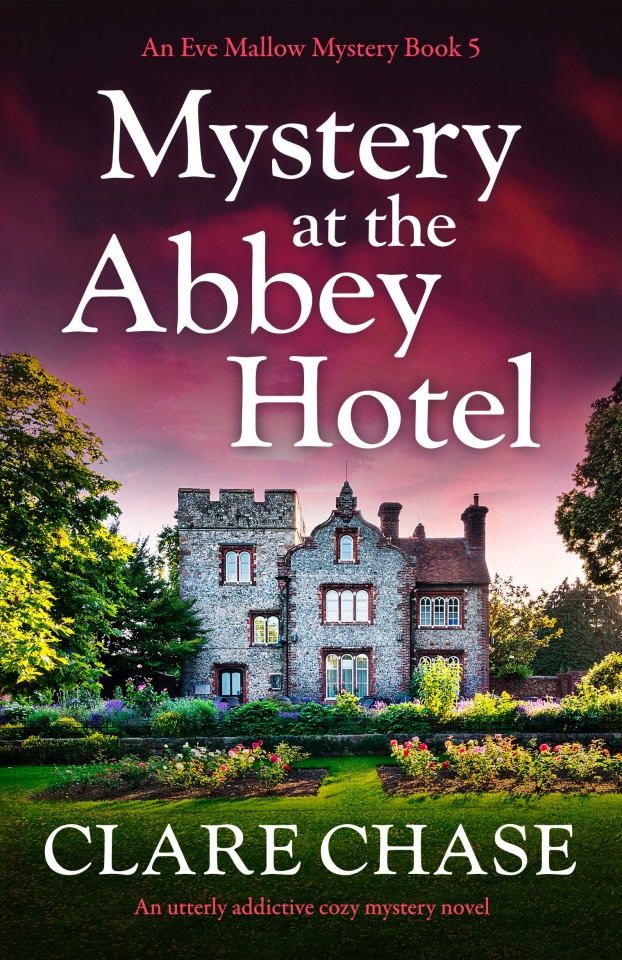
Mystery at the Abbey Hotel by Clare Chase (Eve Mallow Mystery #5)
My Review (5*)
I love this series and i think this is the best installment so far.
It's gripping, complex and highly entertaining, an interesting whodunnit that i thoroughly enjoyed.
Eve is at her best, I loved how she observes and she's able to understand how the relationships between the people works and how the author developed this character adding changes to her life and making her relationships evolve.
The setting is fascinating, I would be happy to be able to sojourn in such a luxurious and unique place.
The plot is tightly knitted, fast paced, full of twists and turns. I wasn't able to guess the culprit and the solution came as a surprise.
I can't wait to read the next book in this series as I think there will be plenty of developments and another excellent mystery.
A very enjoyable story that I strongly recommend.
Many thanks to Bookouture and Netgalley for this ARC, all opinions are mine
Book Description:
Eve Mallow’s stay at the luxurious Abbey Hotel takes a turn for the suspicious when the owner is murdered – leaving Eve surrounded by suspects!
Saxford St Peter is Eve Mallow’s beloved home, but she can’t resist the chance to spend a weekend in the nearby Abbey Hotel, famed for its glamorous owner Debra Moran and an array of celebrity guests. For a confirmed people-watcher like Eve, it’s perfect: she can observe the rich and famous while sipping tea in the gardens, her faithful dachshund Gus by her side.
But her relaxing break takes a shocking turn when Debra is found lying dead in the shadowy woods around the hotel. One of Eve’s fellow guests didn’t come to the Abbey for fine food and delightful décor – but to kill.
When the investigation gets underway, Eve finds herself trapped with a wide range of suspects. Could it be Debra’s new friend Harper, who inherits everything? Her ex-husband Chester, still seething over their messy divorce? Or her estranged sister Amelia, who came hoping for reconciliation, only for Debra to shut the door in her face?
As Eve roams the hotel, searching for clues and hunting down alibis, she uncovers a whole host of secrets. But can she find the truth before the killer brings her holiday to a deadly end?
BUY LINKS:
https://geni.us/B08NXTH8LMsocial
The author:
Clare Chase writes classic mysteries. Her aim is to take readers away from it all via some armchair sleuthing in atmospheric locations.
Her debut novel was shortlisted for Novelicious's Undiscovered Award, as well as an EPIC award post-publication, and was chosen as a Debut of the Month by LoveReading. Murder on the Marshes (Tara Thorpe 1) was shortlisted for an International Thriller Writers award.
Like her heroines, Clare is fascinated by people and what makes them tick. Before becoming a full-time writer, she worked in settings as diverse as Littlehey Prison and the University of Cambridge, in her home city. She's lived everywhere from the house of a lord to a slug-infested flat and finds the mid-terrace she currently occupies a good happy medium.
As well as writing, Clare loves family time, art and architecture, cooking, and of course, reading other people's books.
You can find Clare's website and blog at www.clarechase.com
Author Social Media Links:
Twitter: https://twitter.com/ClareChase_
Goodreads: https://www.goodreads.com/author/show/10204574.Clare_Chase
Facebook: https://www.facebook.com/ClareChaseAuthor/
0 notes
Note
How would you write grantchester season 4?
oh, dear, okay, hmmm.
I’d write series 4 based off stories from the problem of evil and the forgiveness of sins. in the problem of evil, fellow priests are murdered and sidney, who has married hildegard, returns to sleuthing.
I don’t ever see that happening, sidney and hildegard marrying, so, to be honest, I wouldn’t write sidney marrying. I’d actually like to see him learn to be on his own, find himself again.
I would create a bigger murder club, bring in more people sidney and geordie can investigate crimes with, and just have more friends, in general. as much as I love geordie and sidney, and leonard, I feel like the show could use a few new faces and friendships.
and I still don’t like daniel (is that his name?), so I’d get rid of him and find someone else, someone nicer, for leonard.
and I’d bring back jennifer chambers and make her a regular.
In the fourth grantchester mysteries, the forgiveness of sins, sidney finds himself promoted. Instead of being the vicar at grantchester, sidney becomes the archdeacon at ely cathedral, 20 miles from cambridge but still close enough to get involved in several of geordie’s cases. I’d love to see that development happen for him. it’d be good for him, as well as for leonard to get his own parish.
I don’t know how else I would write it, hm.
4 notes
·
View notes